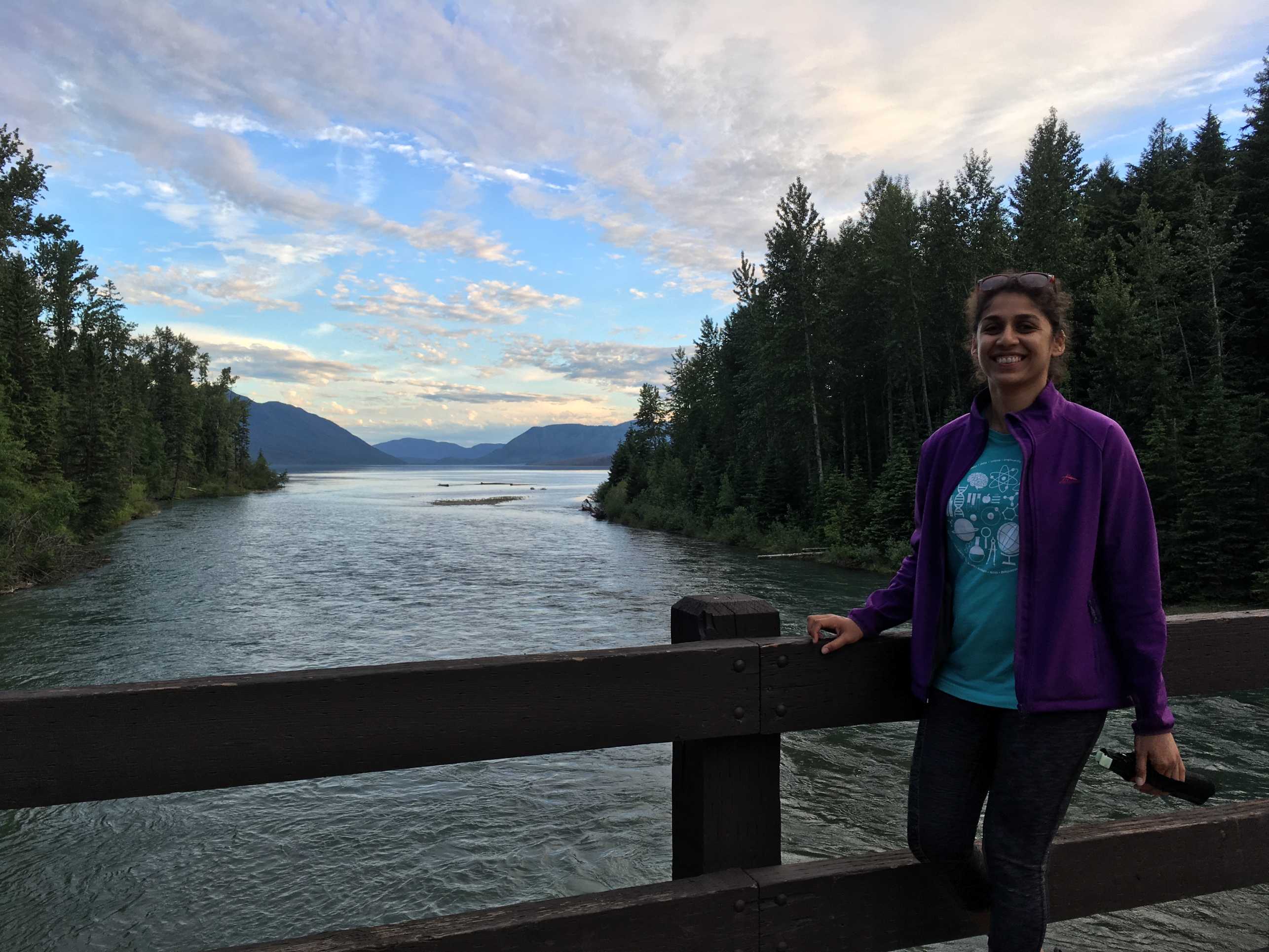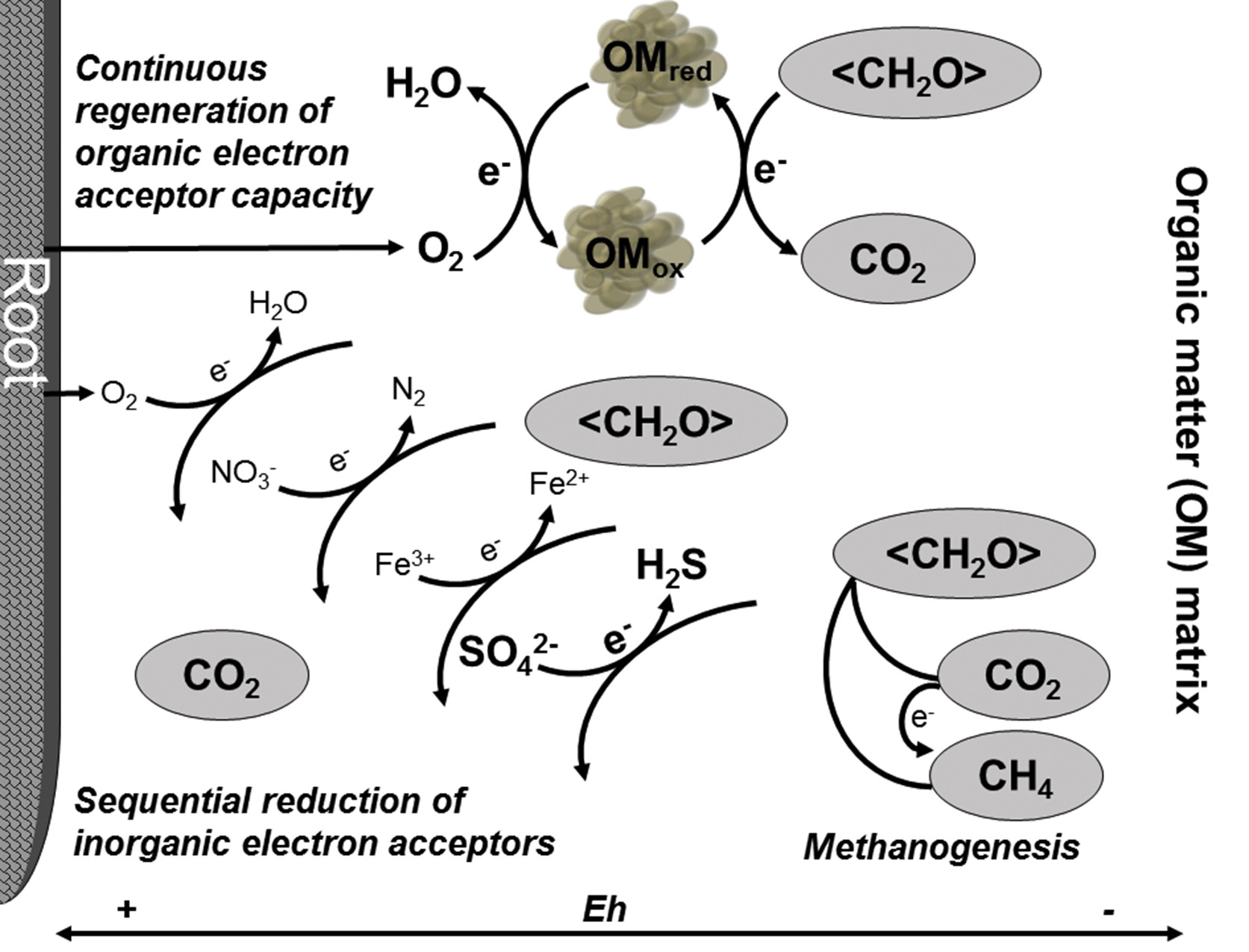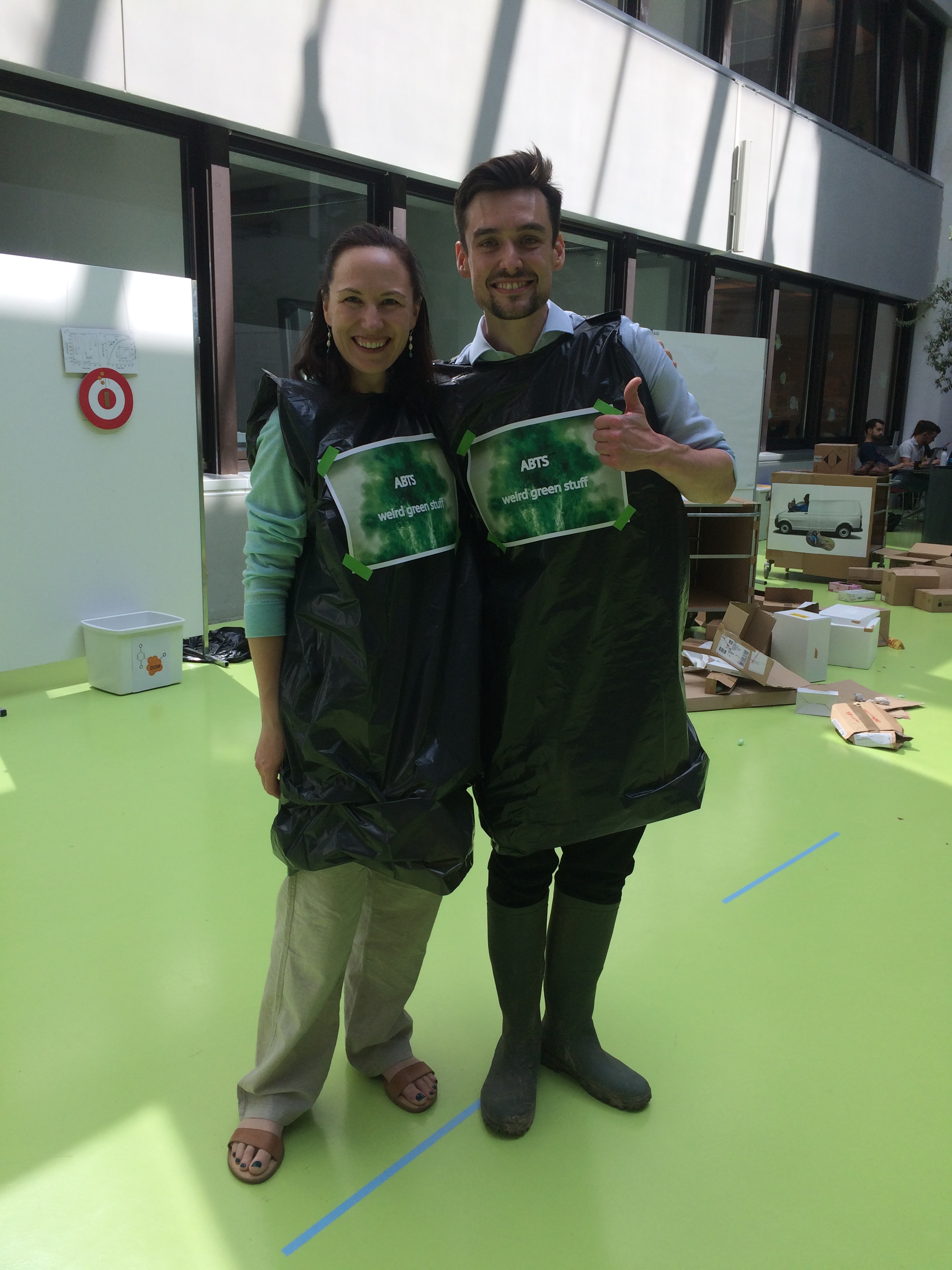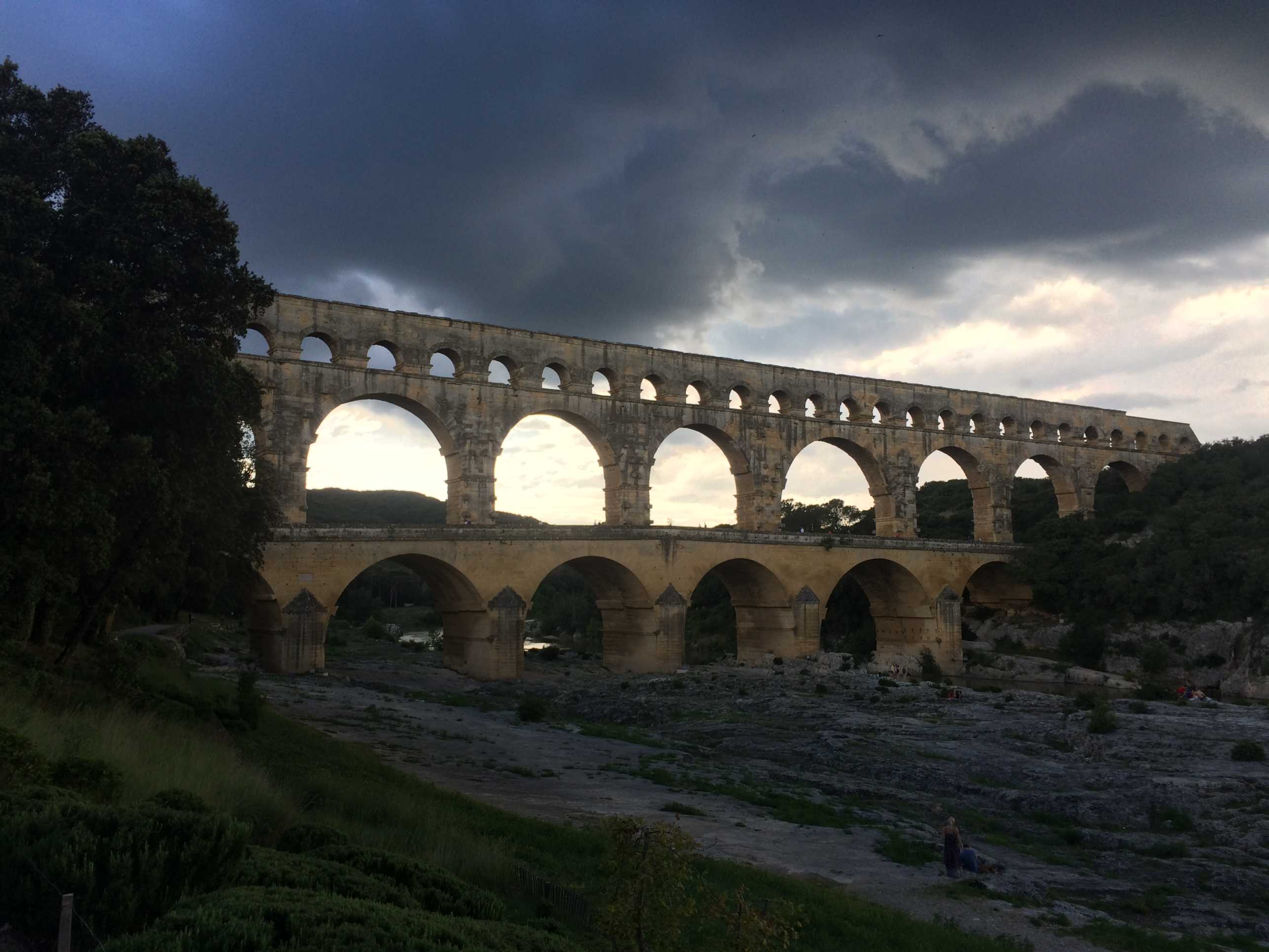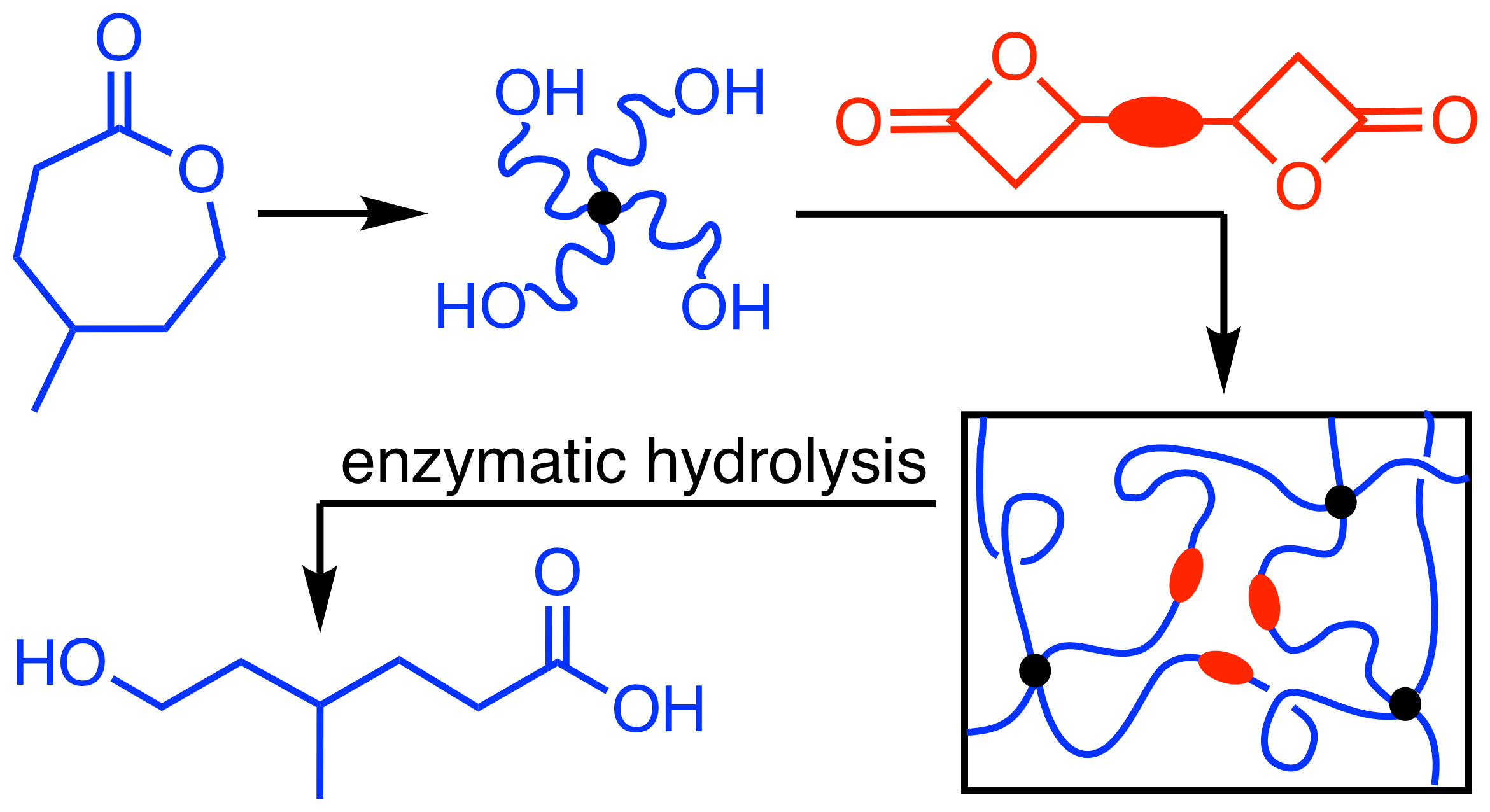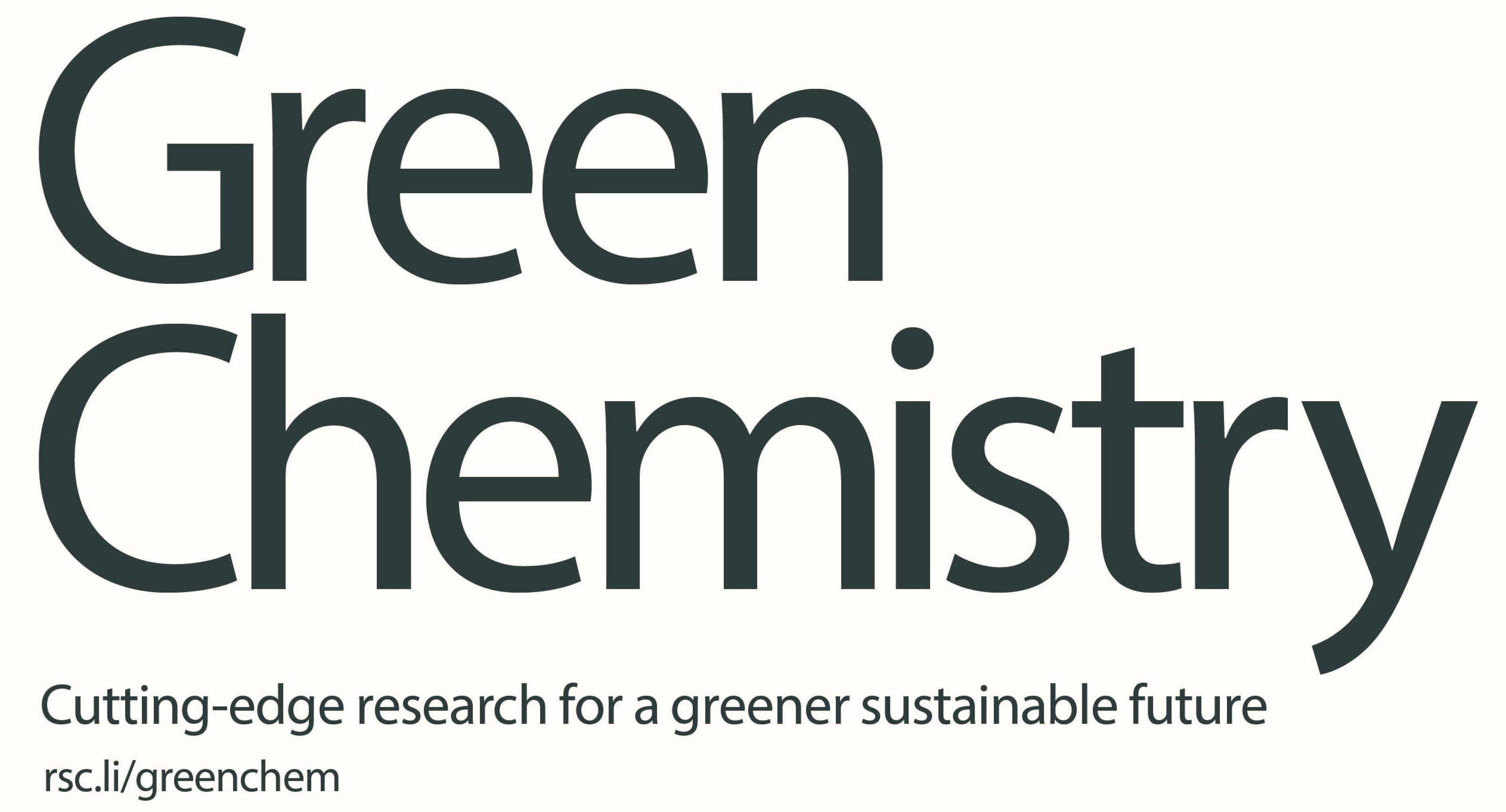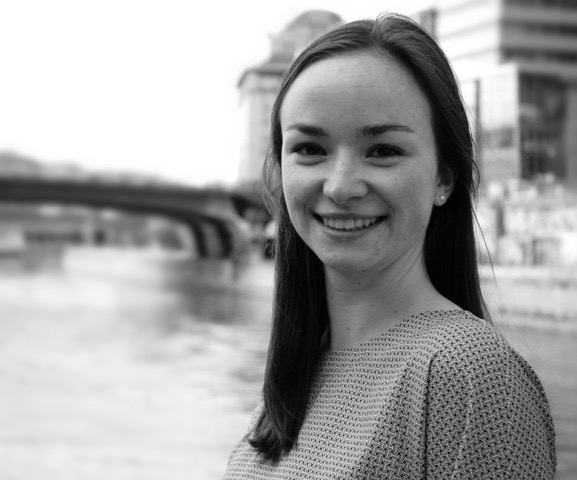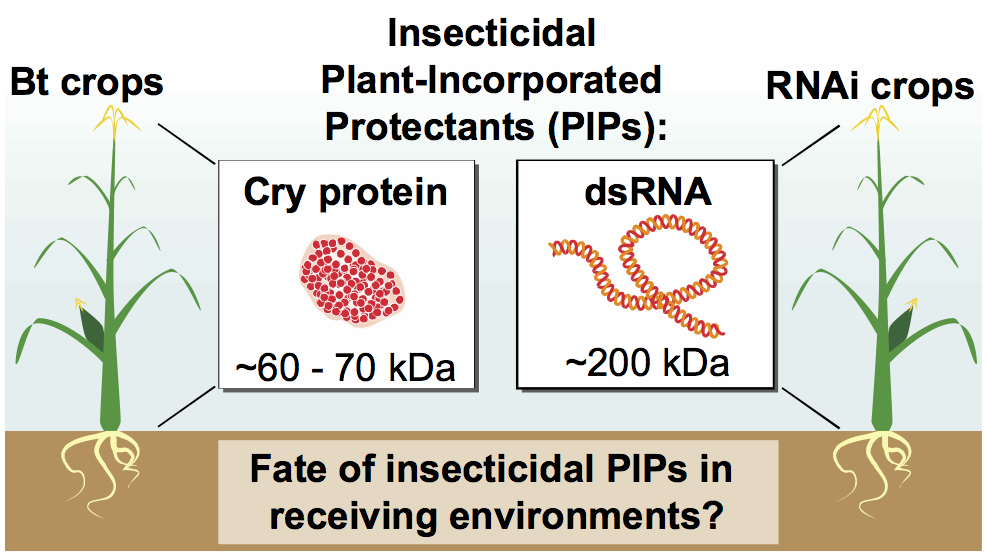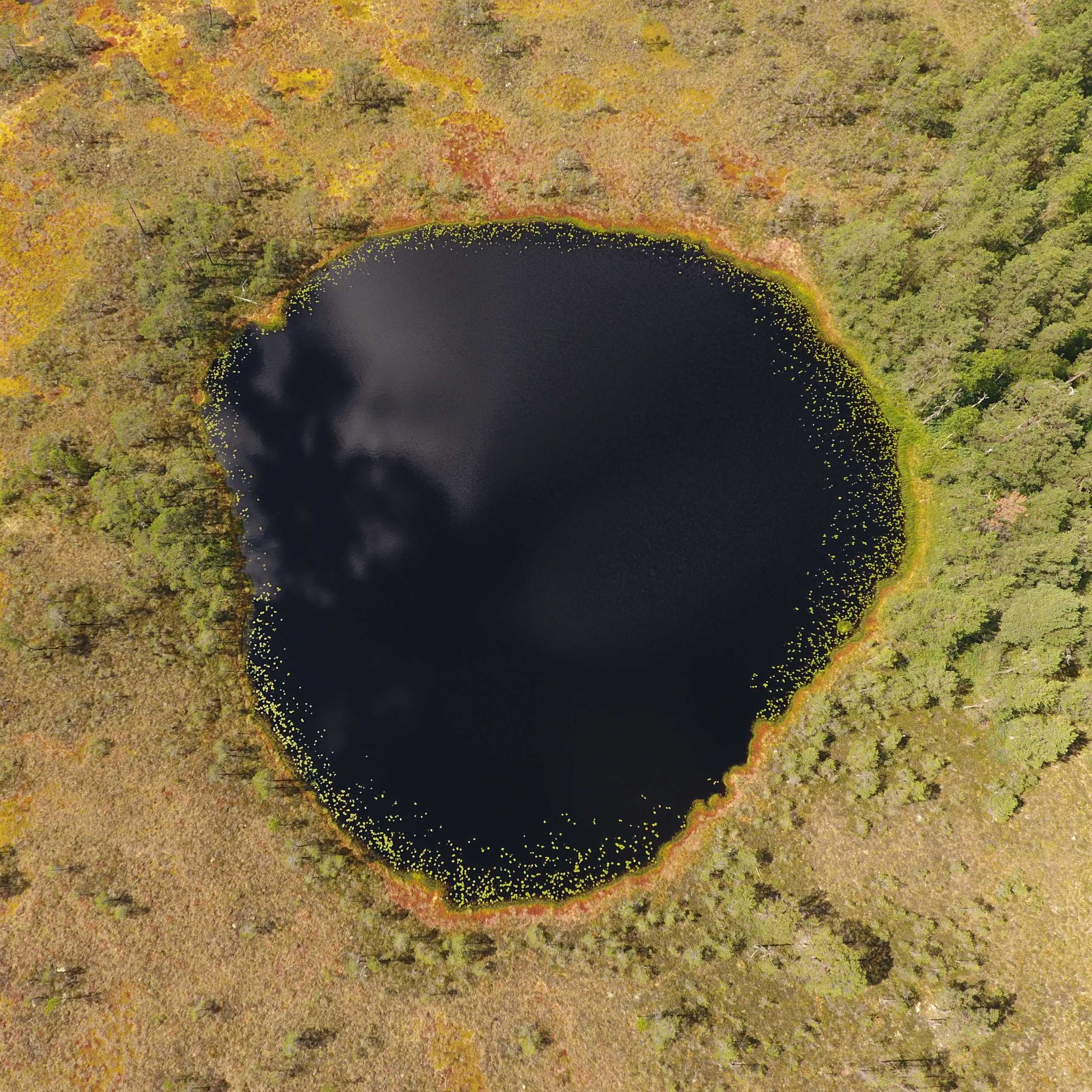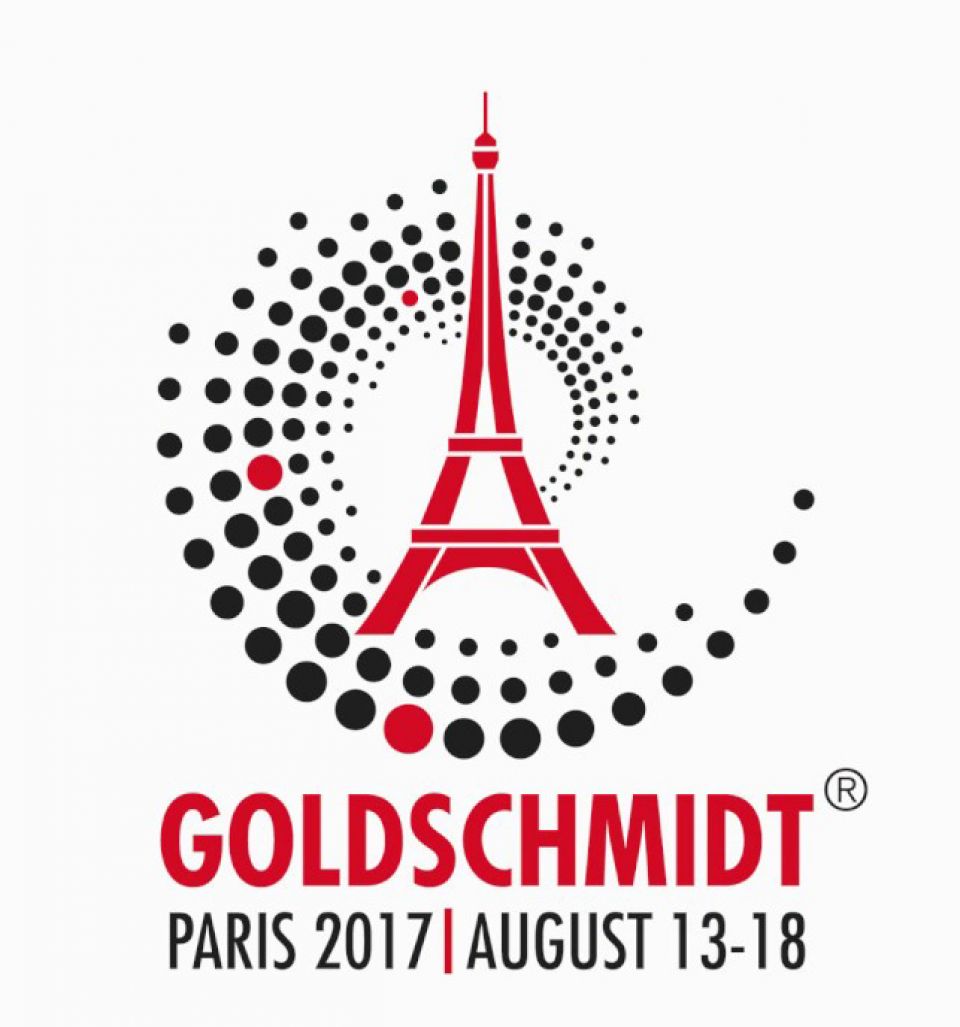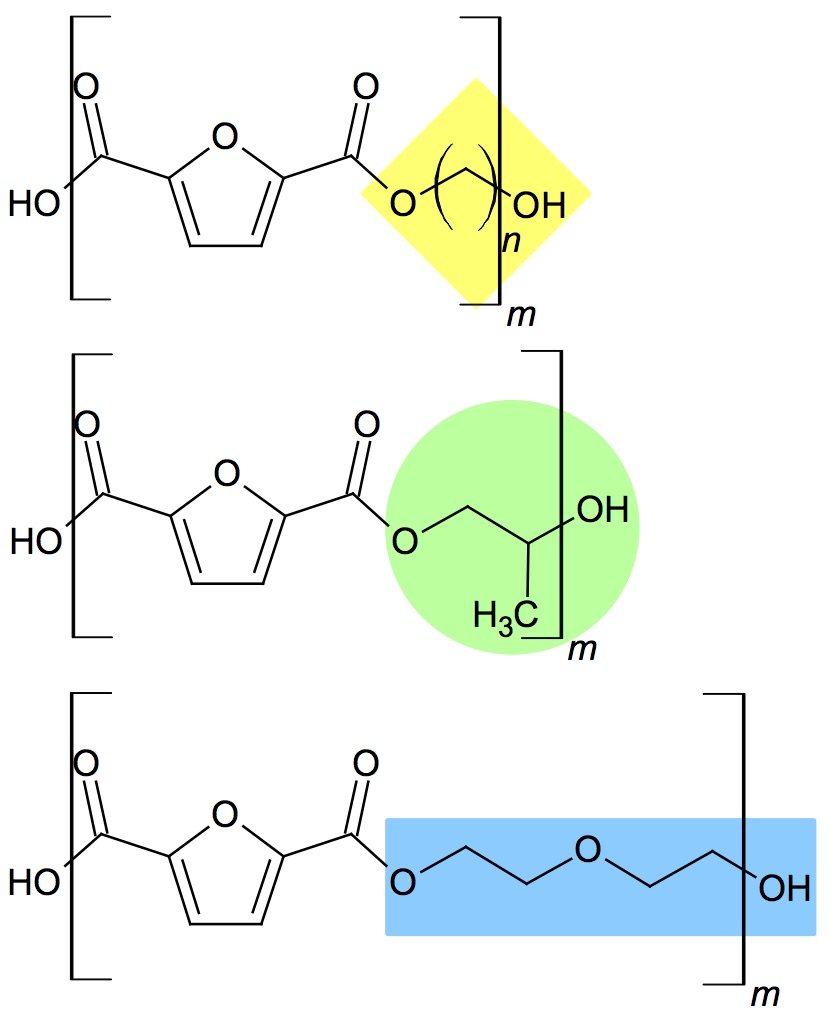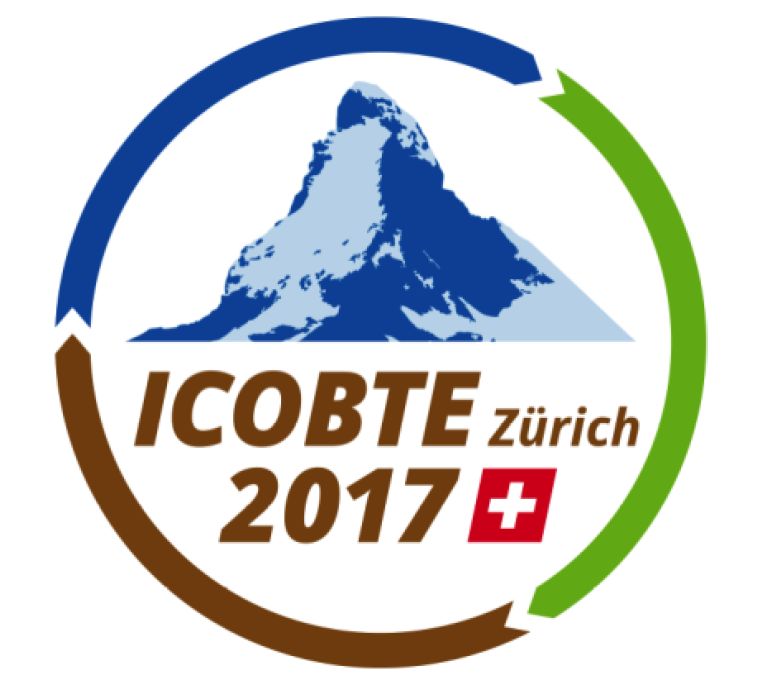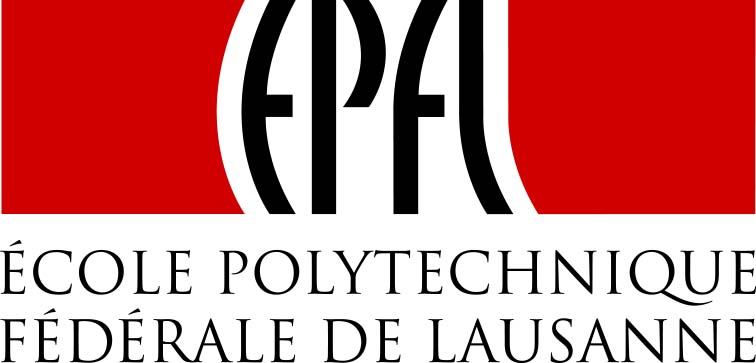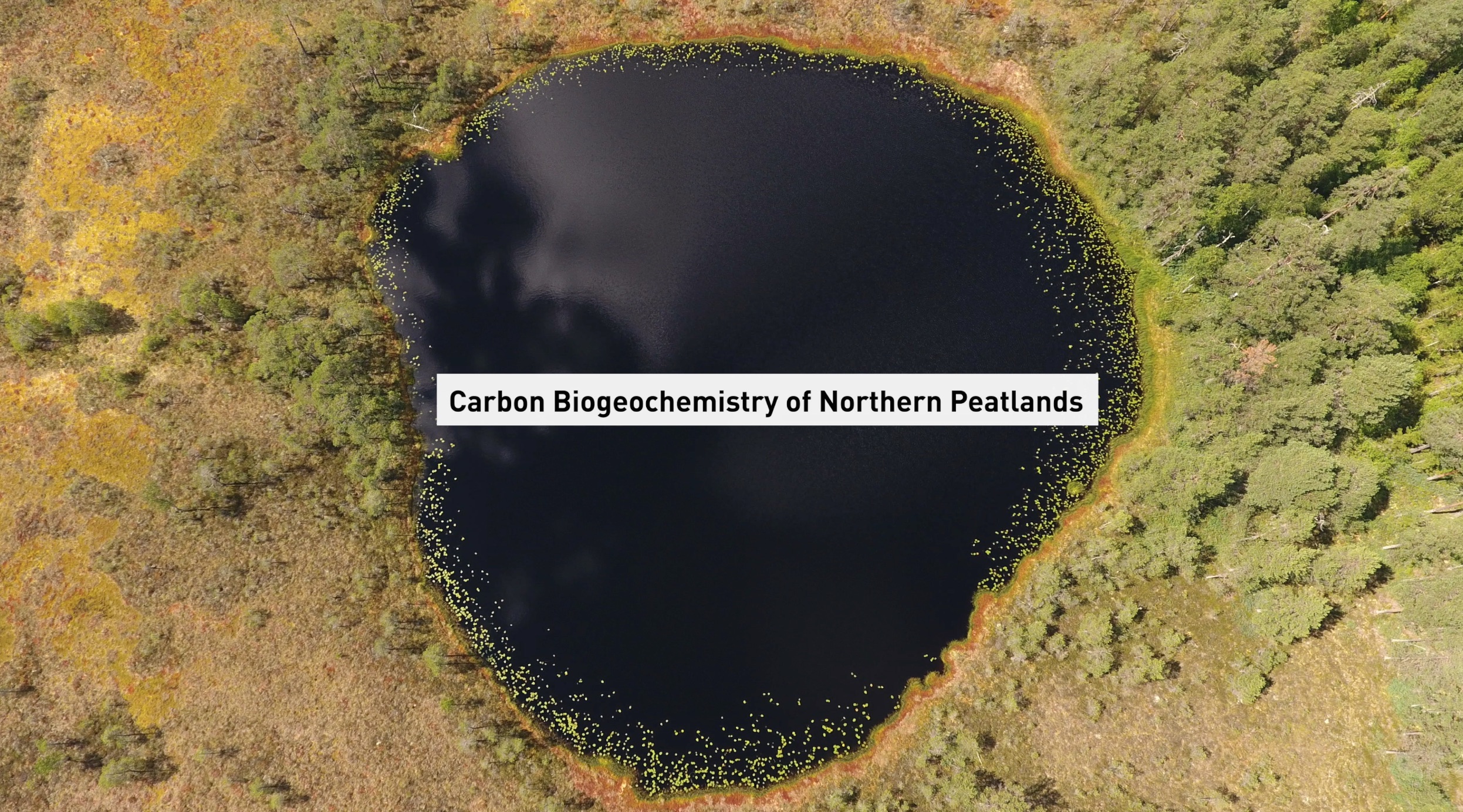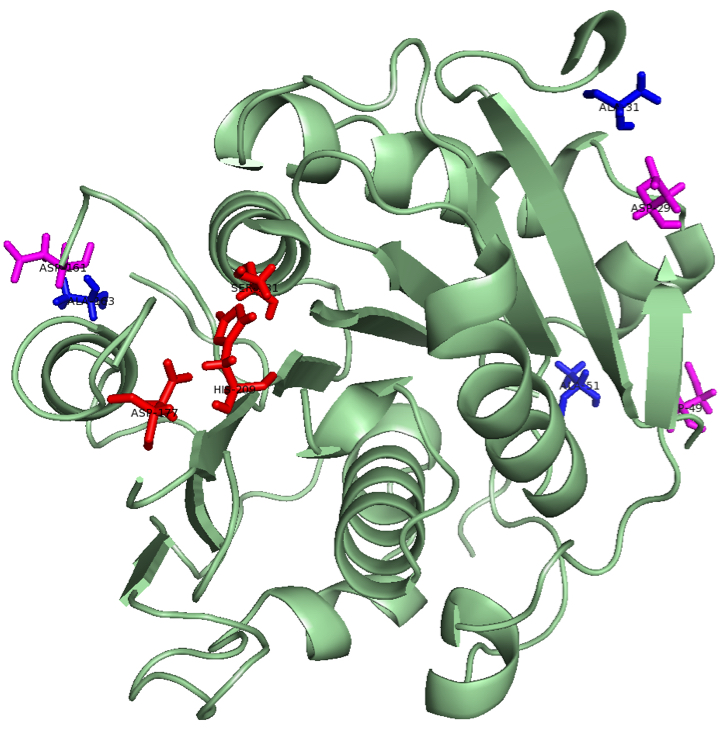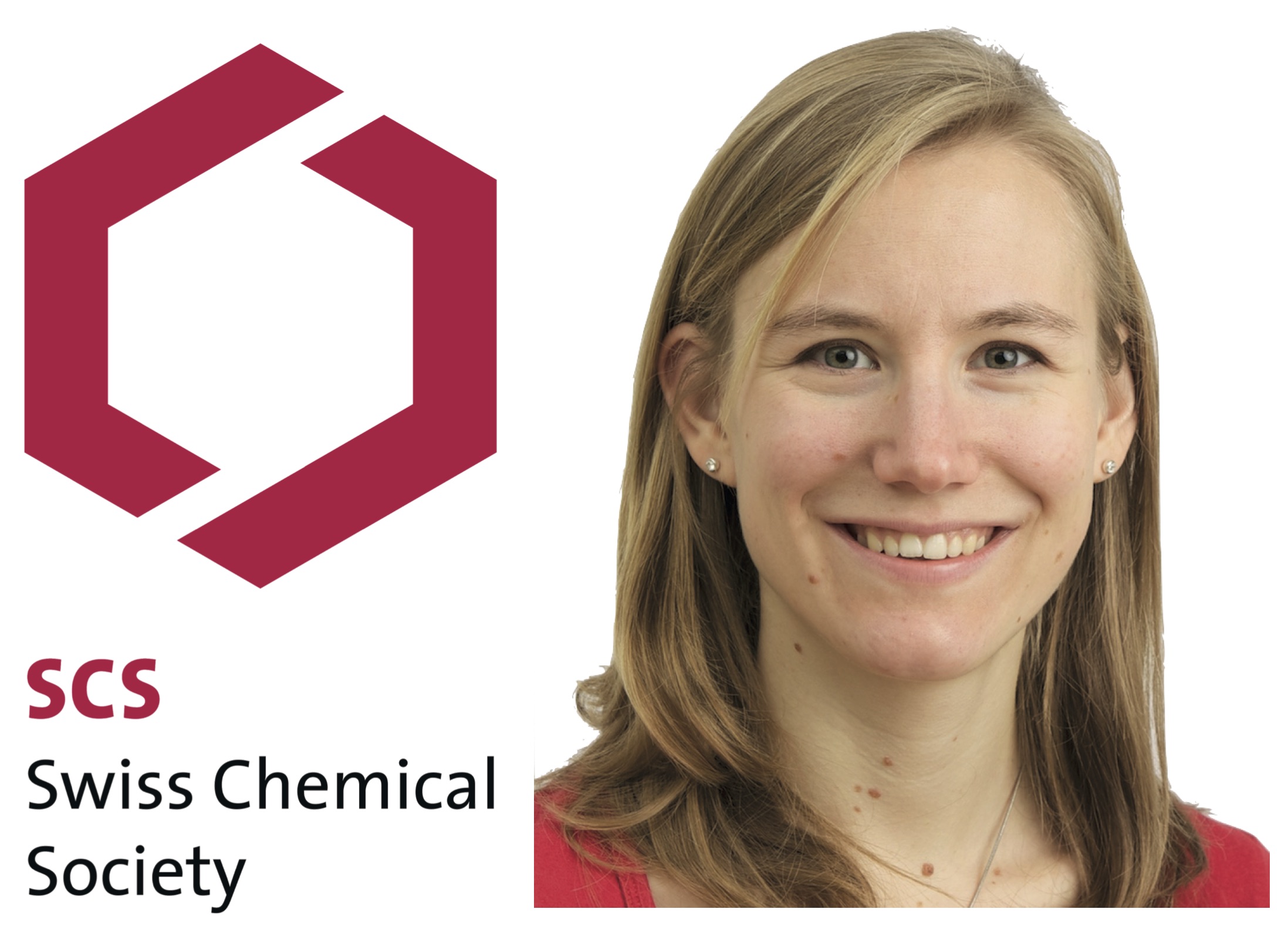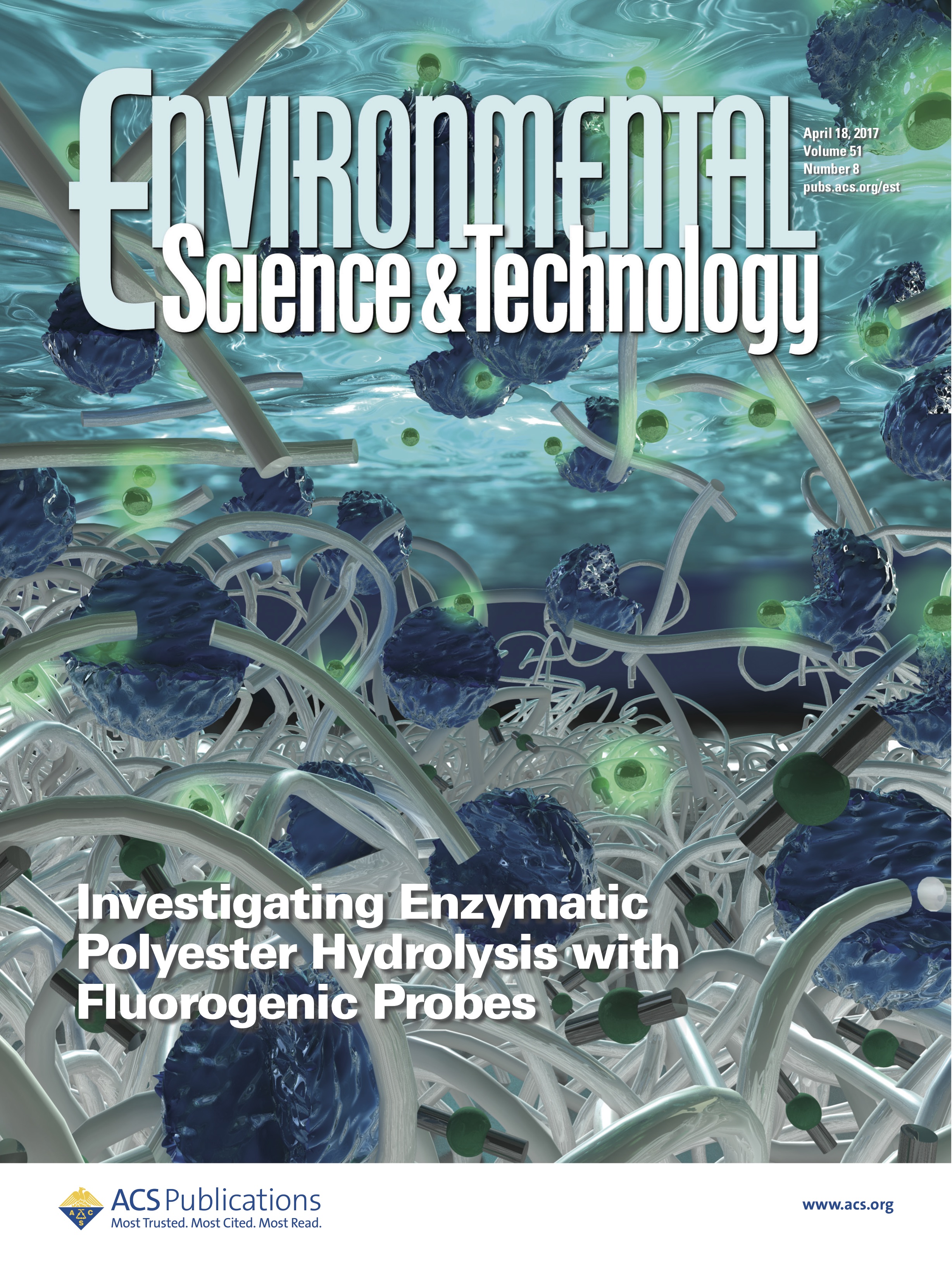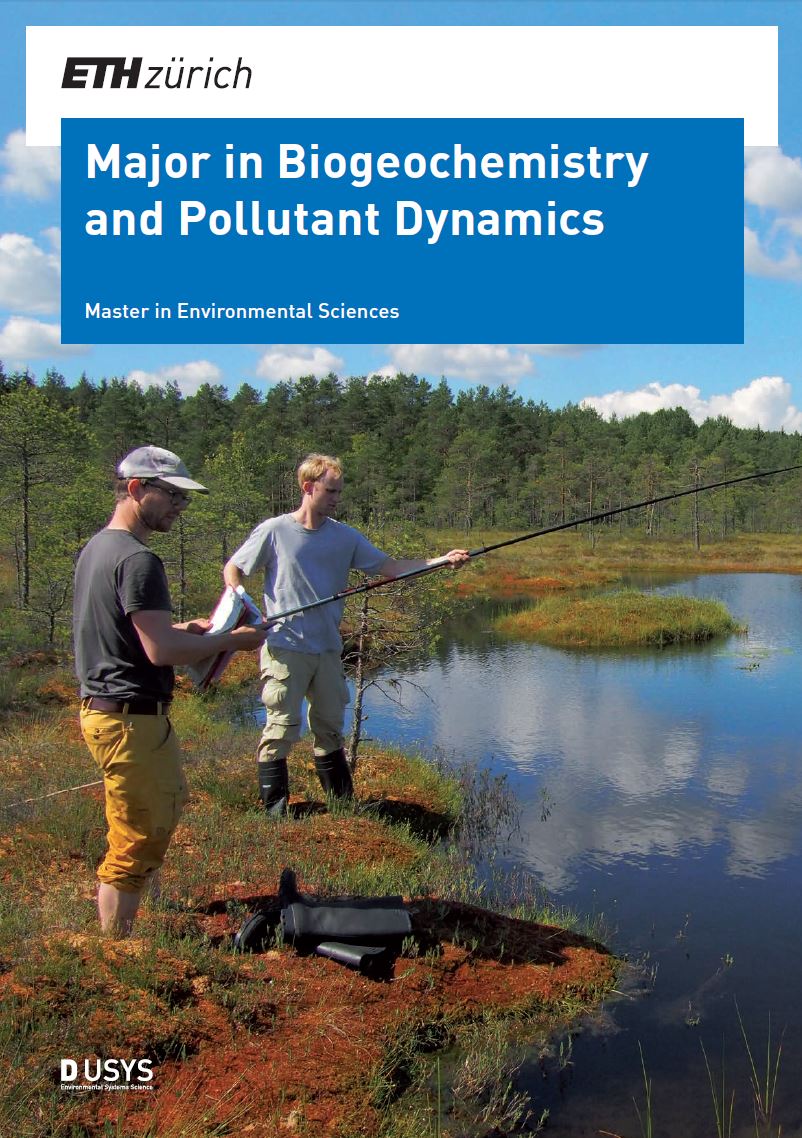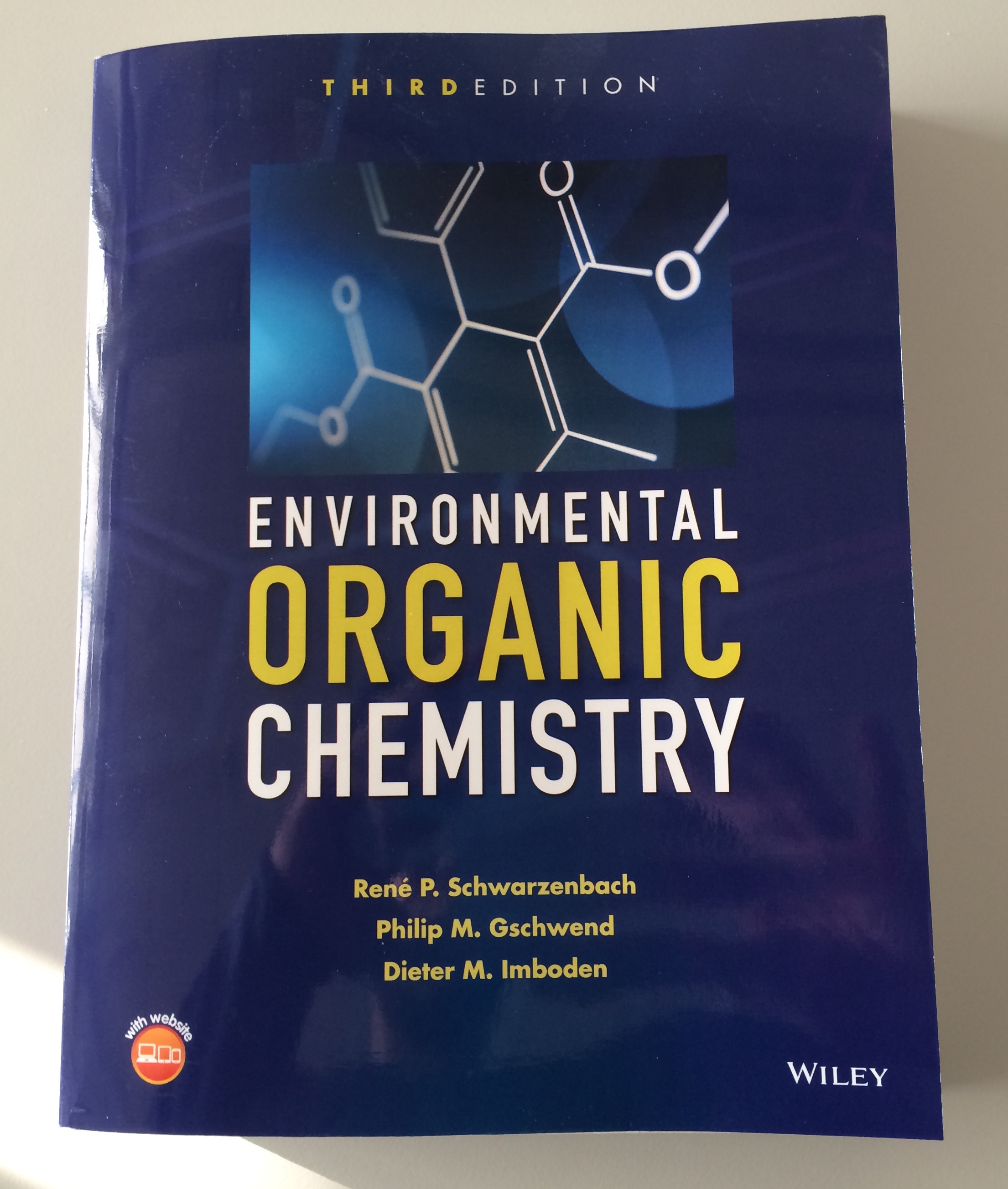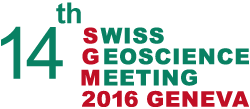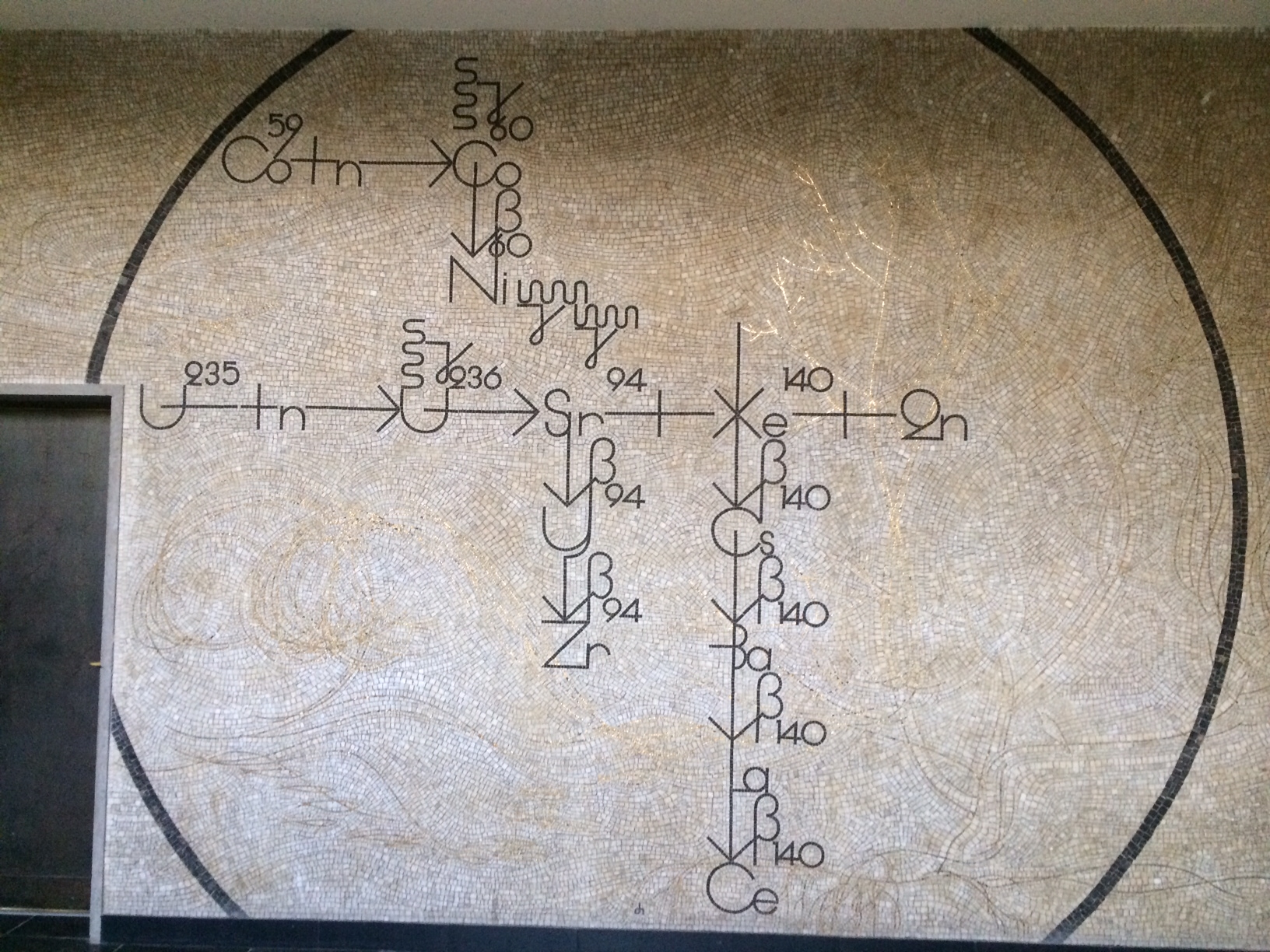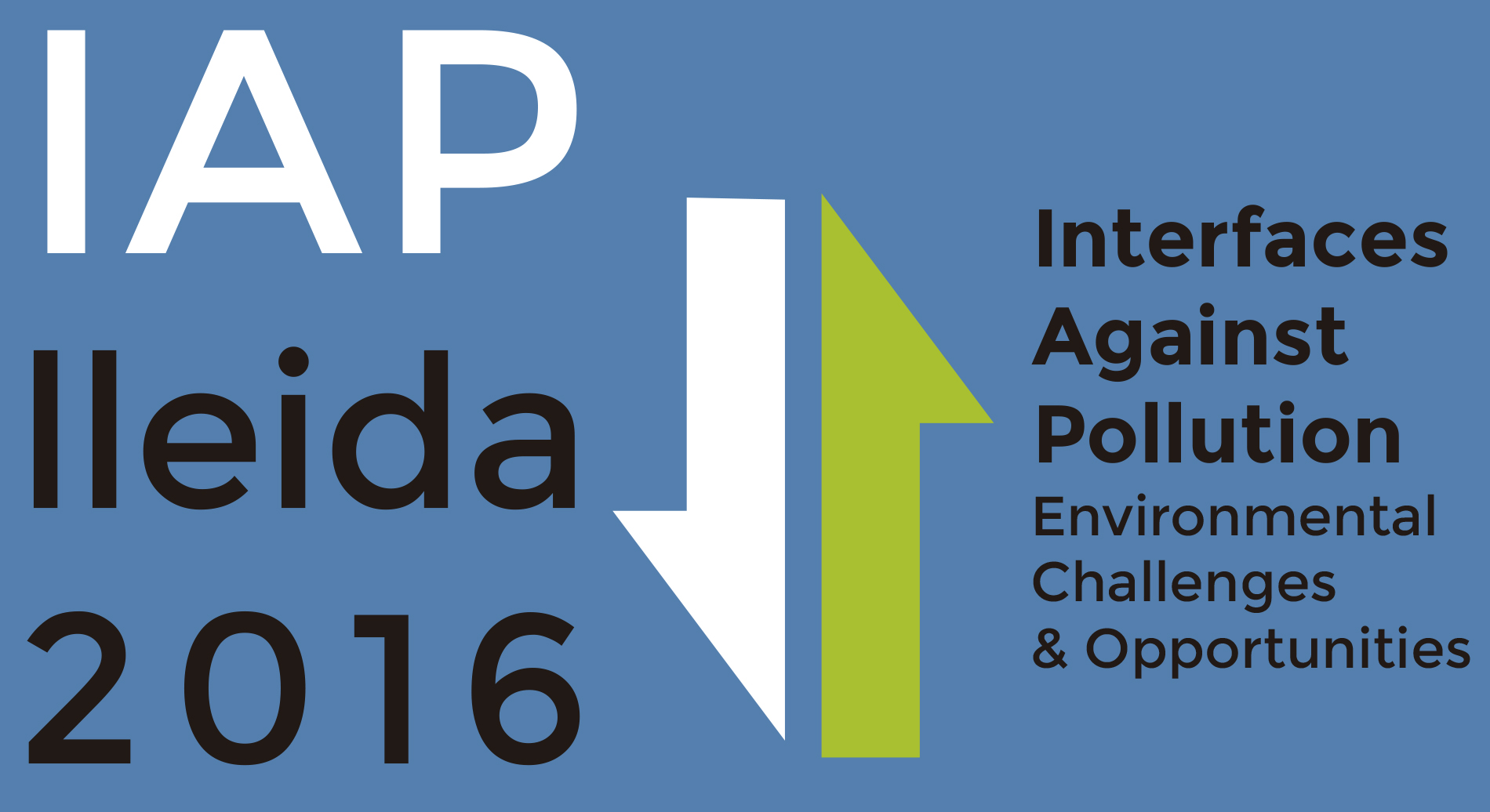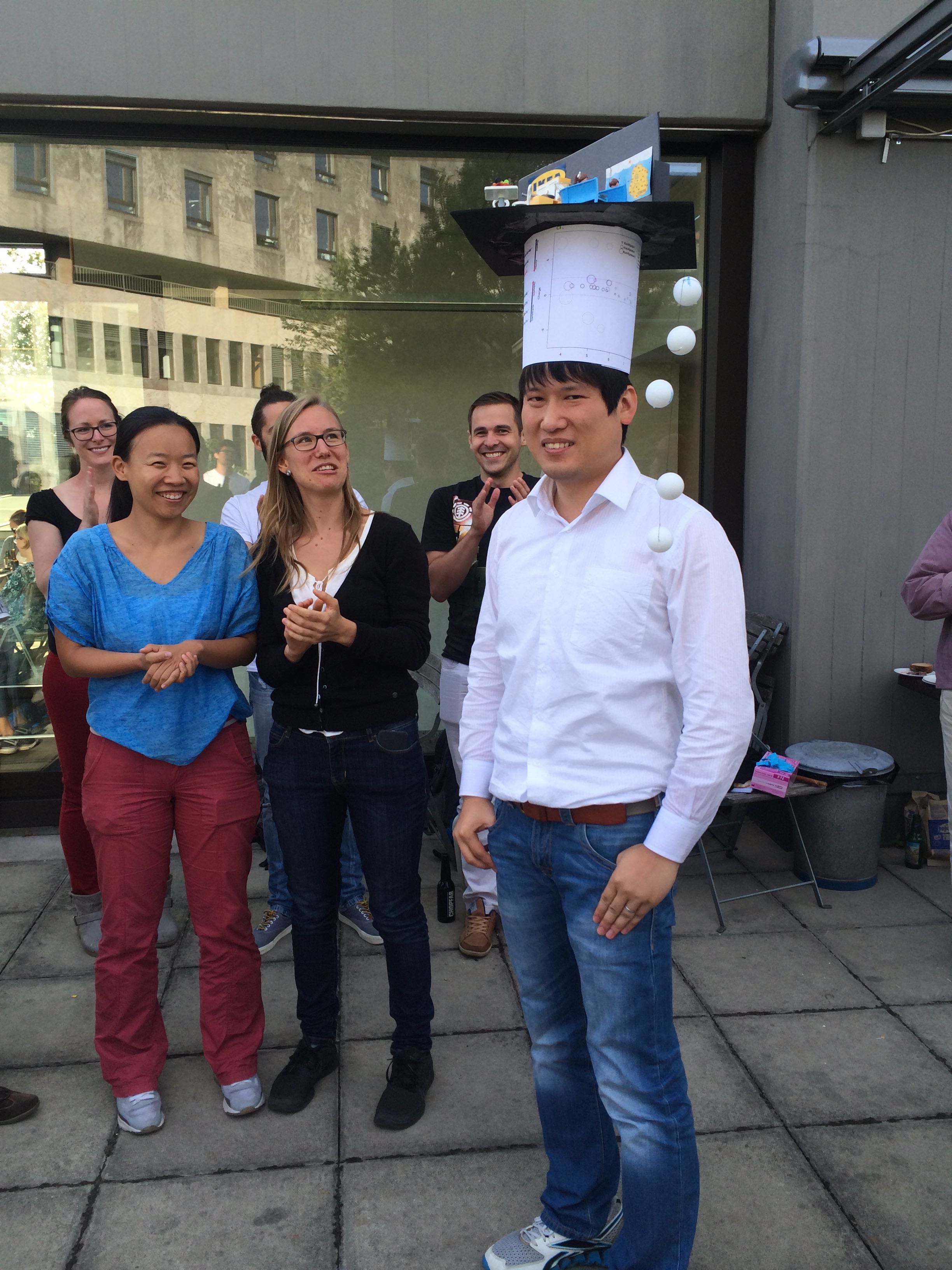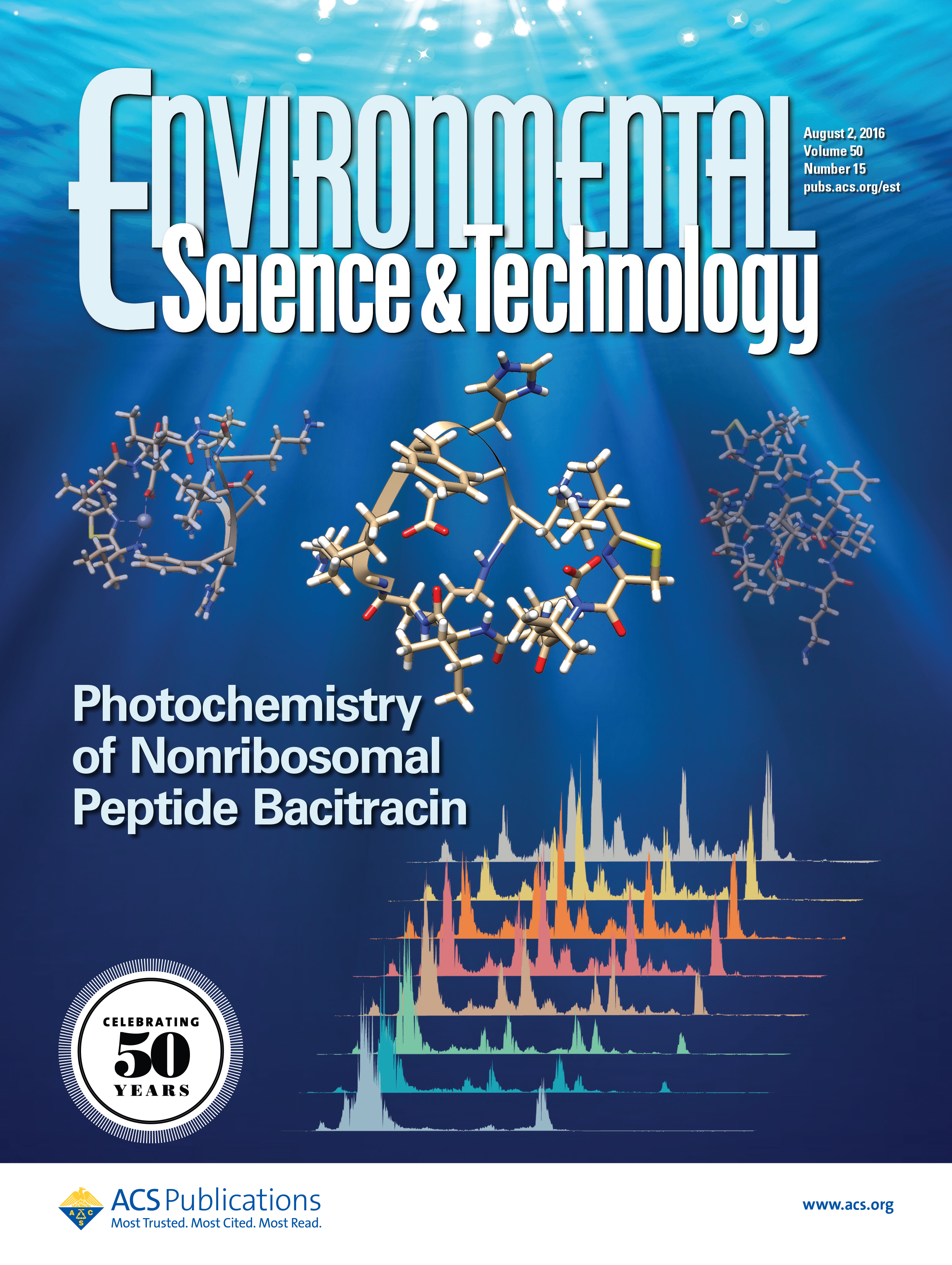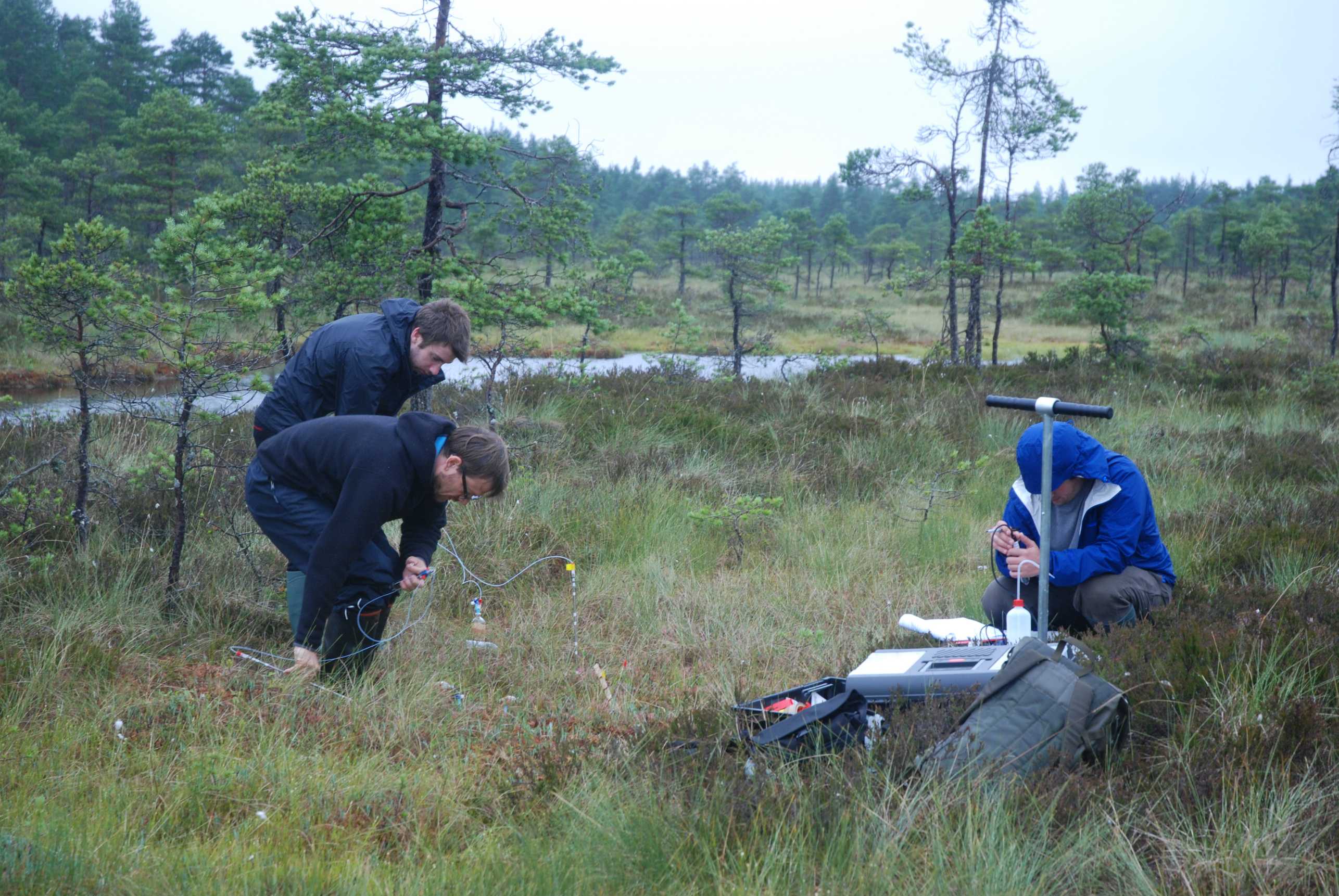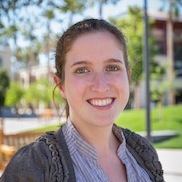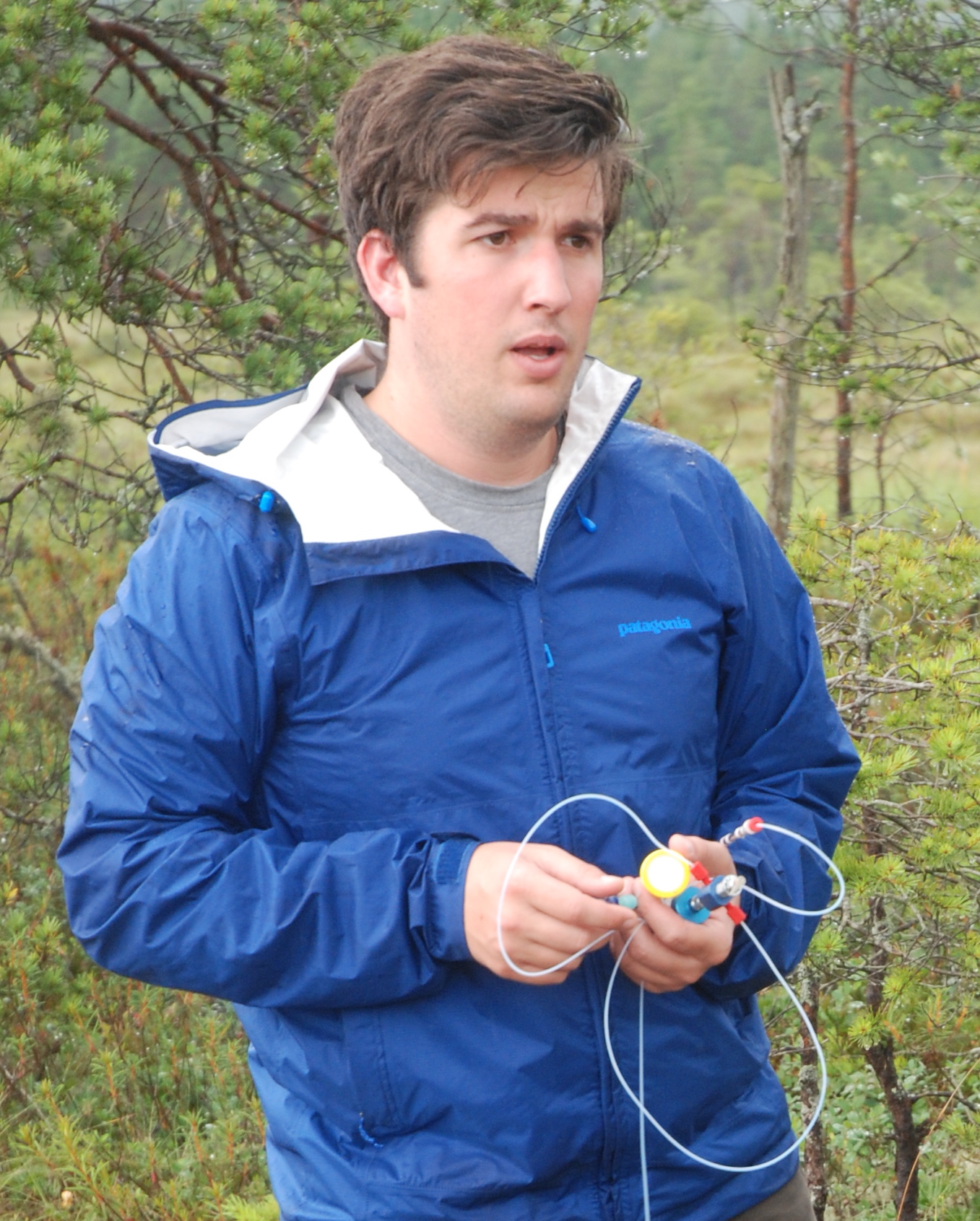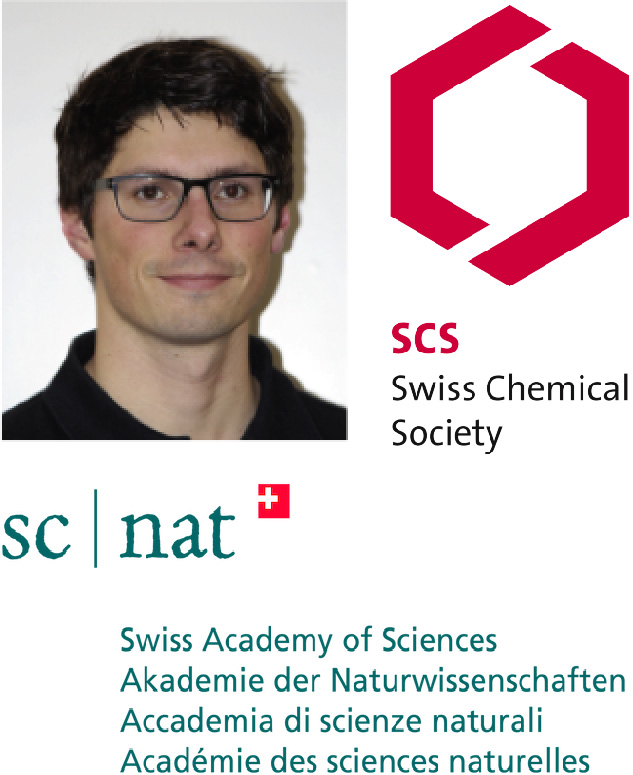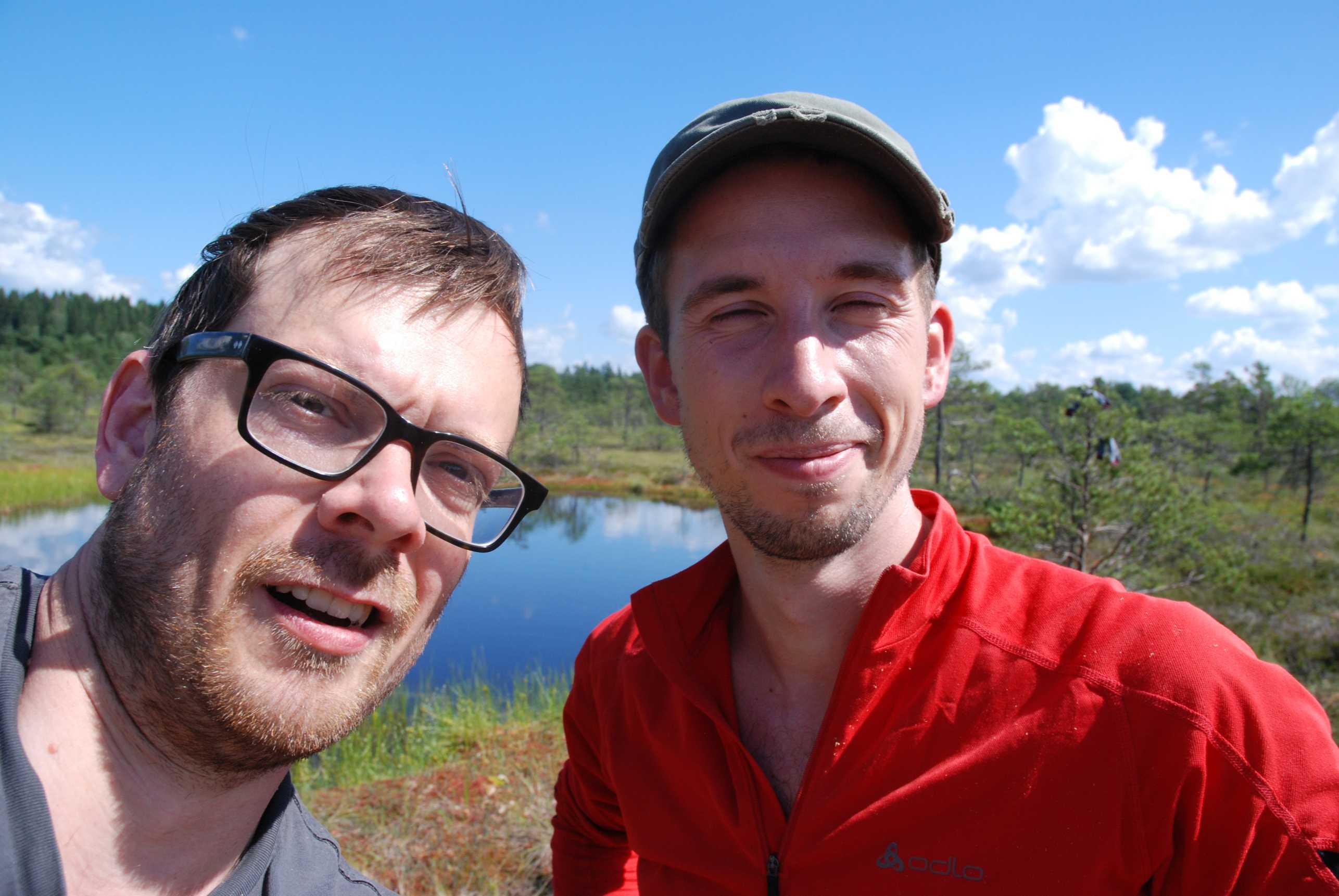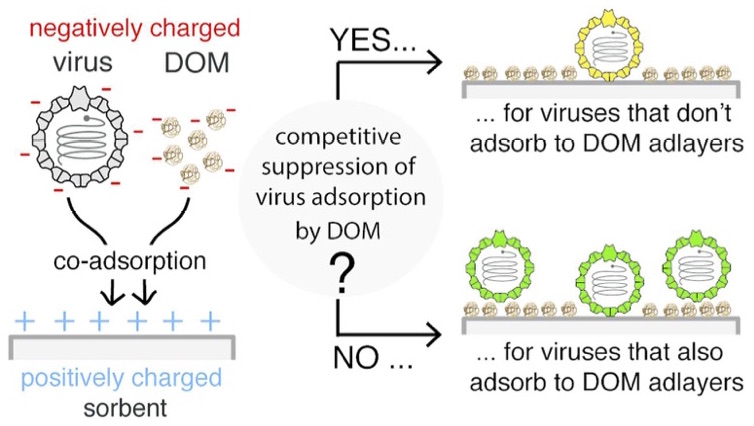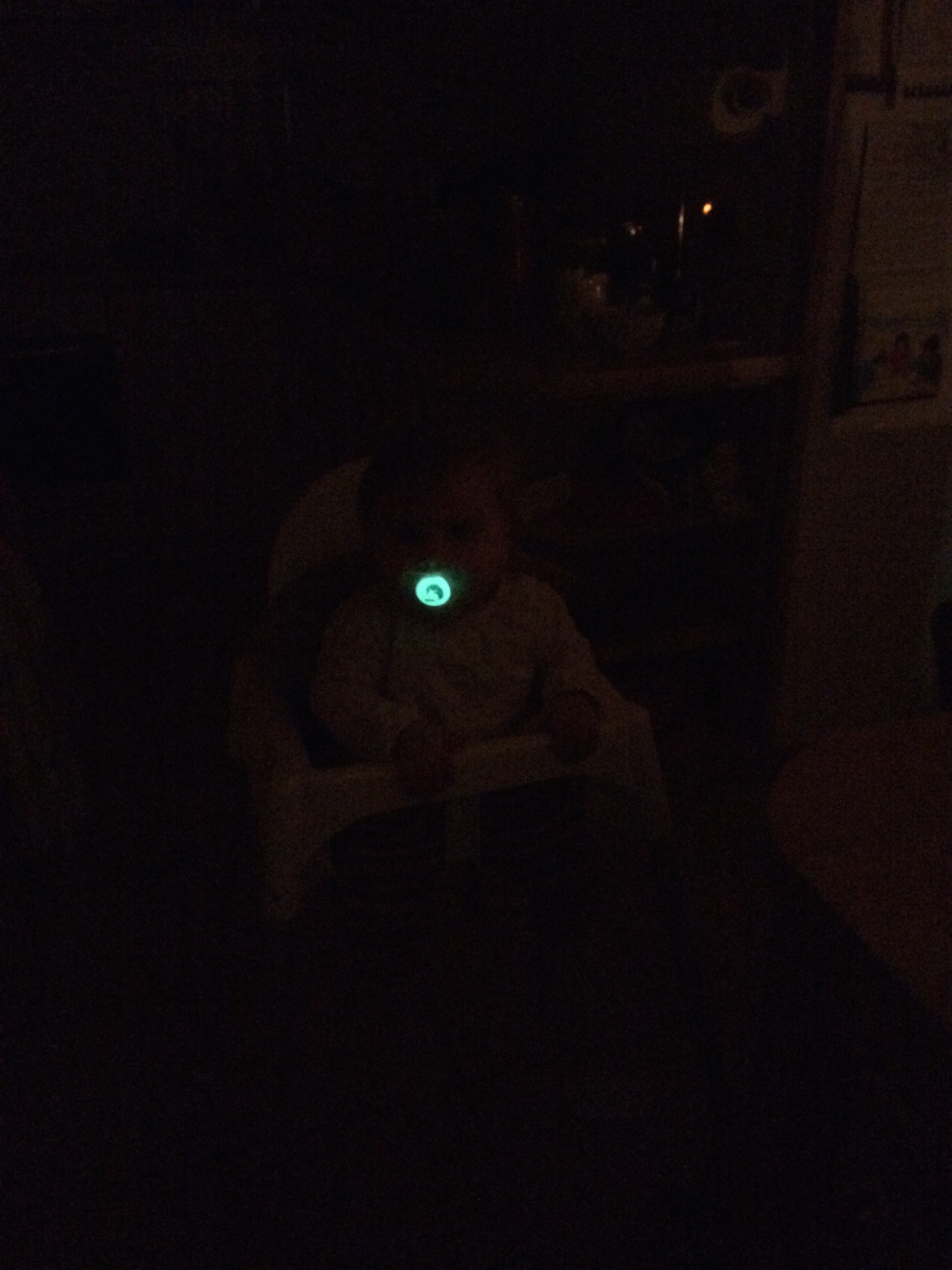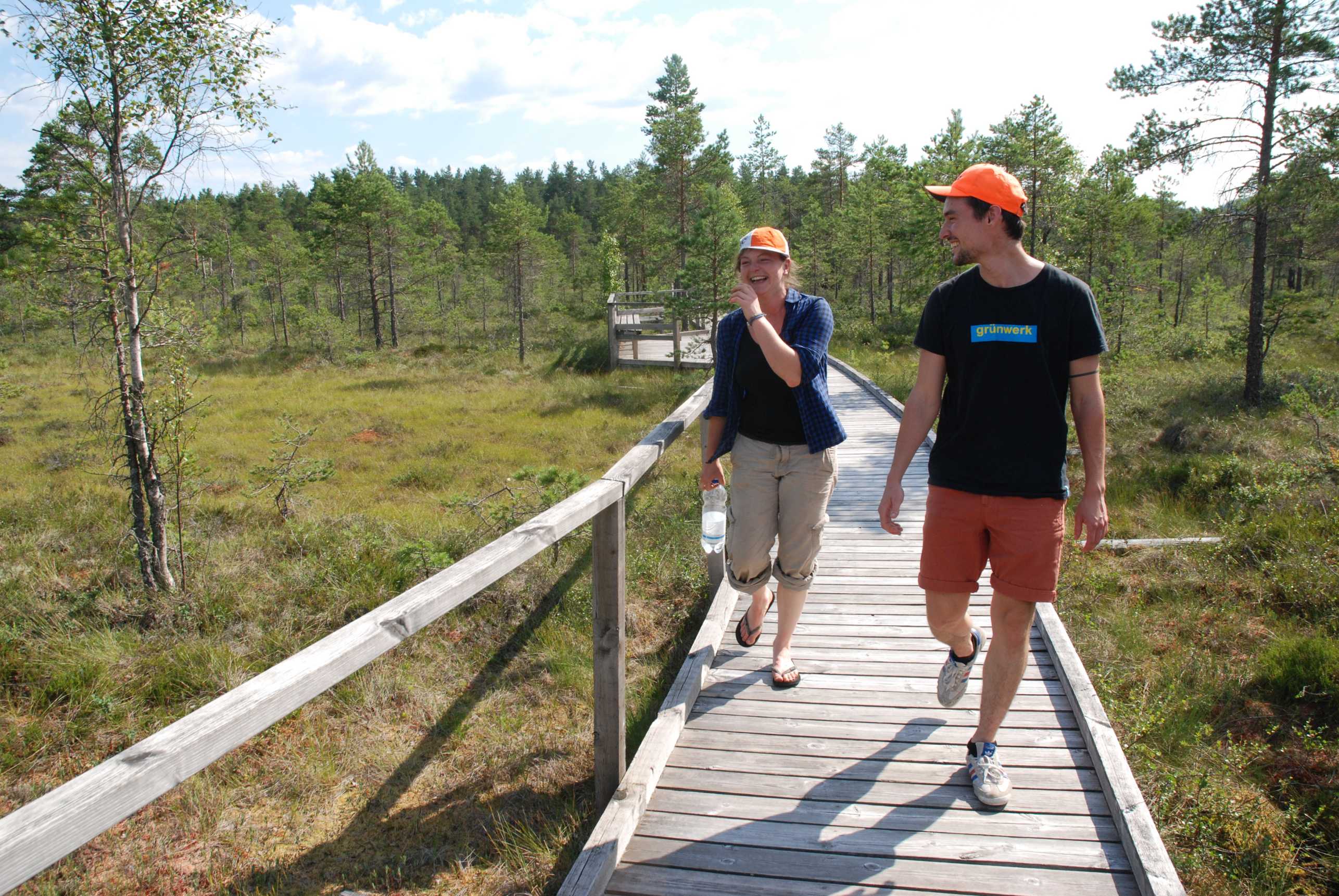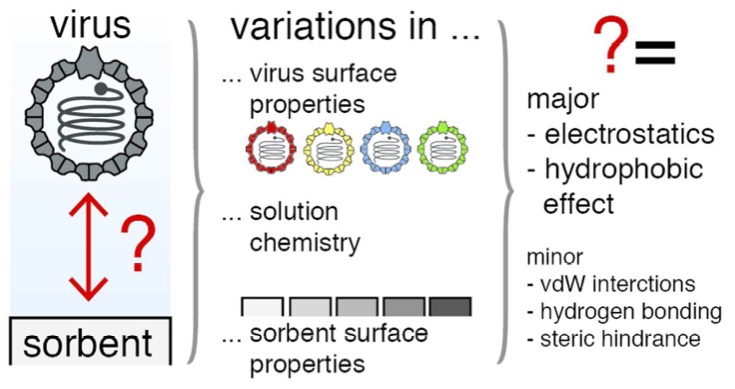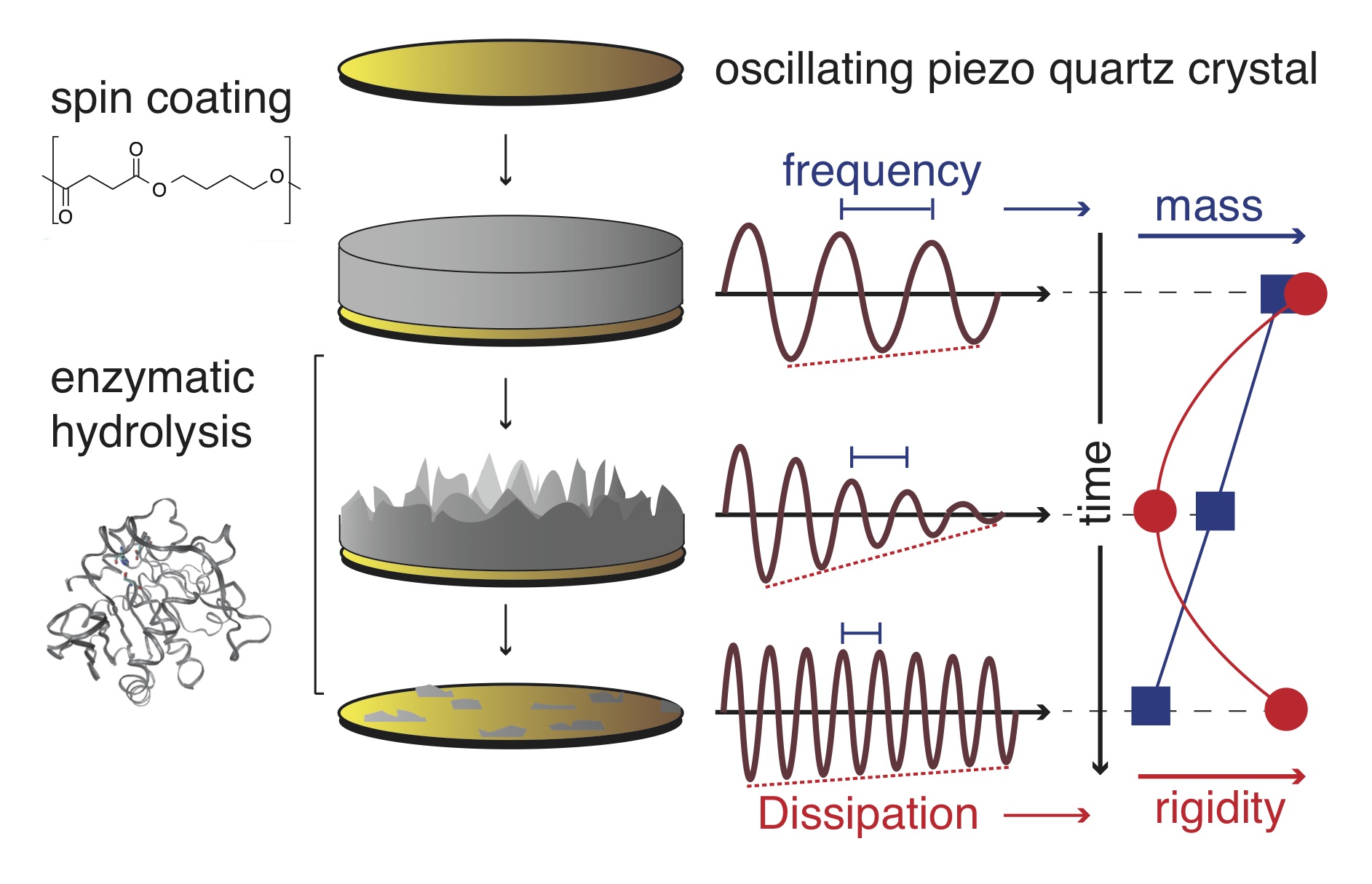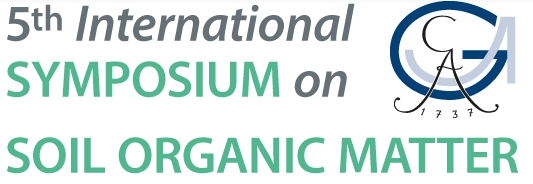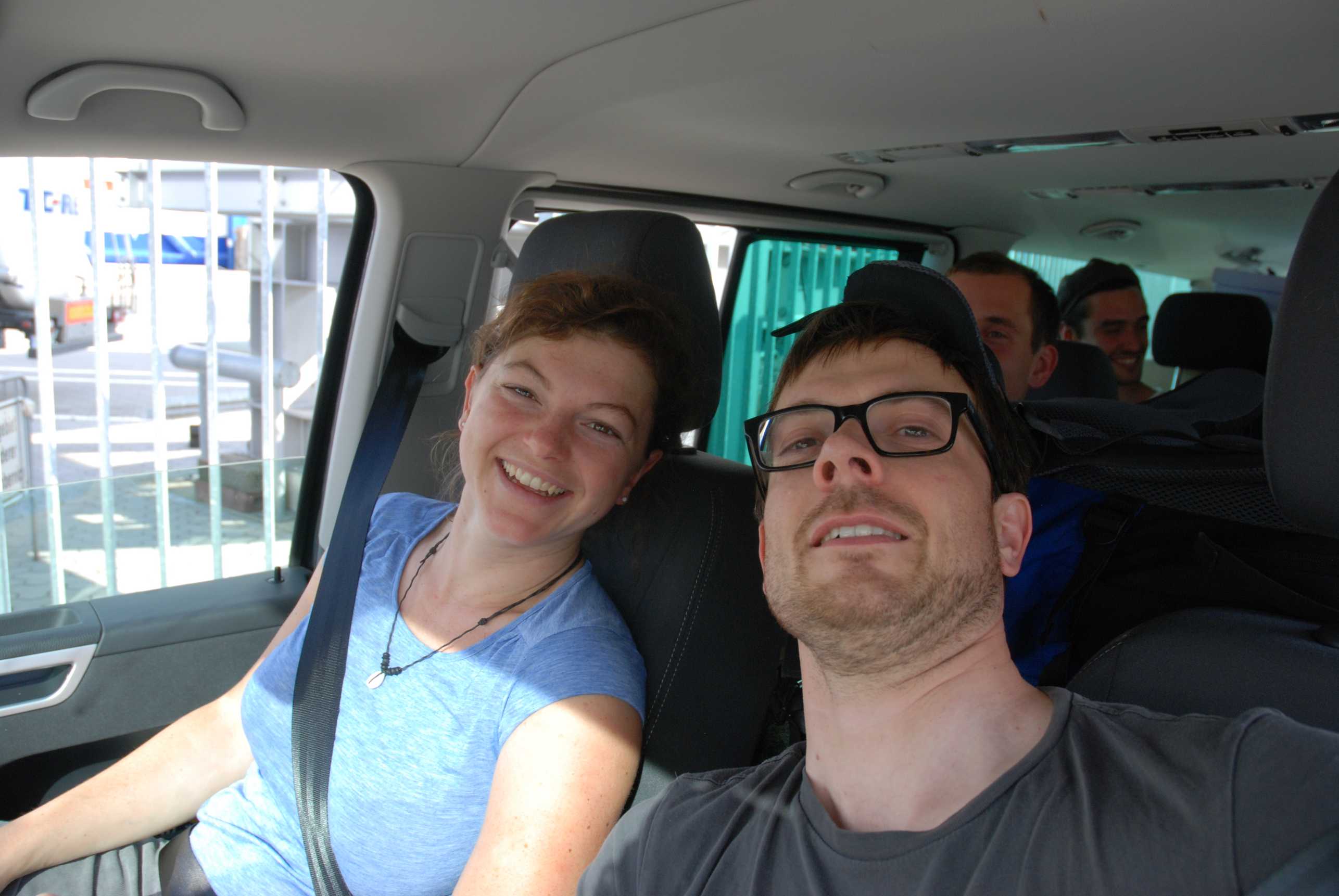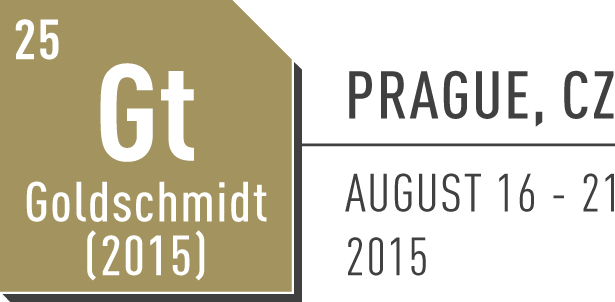News Archive
2019
2018
Prachi Joshi just joined our research group as a postdoctoral researcher. She submitted a research proposal to ETH for which she was awarded one of the prestigous ETH postdoctoral research fellowships. Her research will focus on the redox biogeochemistry of northern peatlands. More specifically, she will investigate the role of peat particulate organic matter as electron acceptor in redox reactions and its effects on peatland methane dynamics. Prachi will be working with both Michi Sander and Martin Schroth.
Nicolas paper on the reduction of dissolved oxygen by peat particulate organic matter in northern peatlands just got accepted in Environ Sci Technol. In this paper, we provide evidence that dissolved oxygen is rapidly consumed through reduction by reduced moieties in peat particulate organic matter in temporarily anoxic parts of a Swedish bog. The approach we took is unique in that we measured oxygen consumption directly in the field. Thanks to everyone involved and particularly to Martin Schroth for introducing the beauty of push pull tests to our group. Congratulations Nicolas!
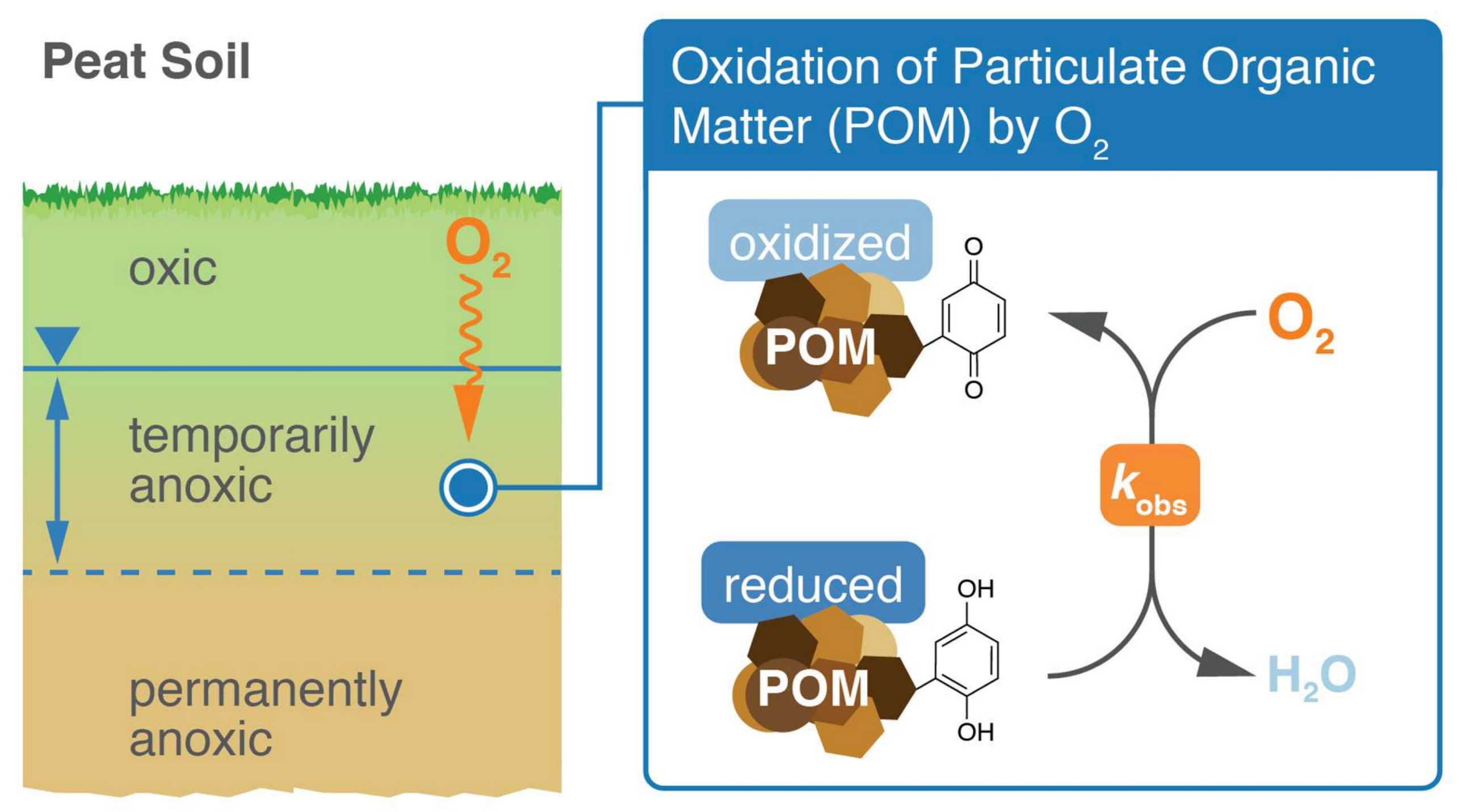
Walpen, N., M. Lau, A. Fiskal, G. J. Getzinger, S. A. Meyer, T. F. Nelson, M. A. Lever, M. H. Schroth, and M. Sander. Oxidation of Reduced Peat Particulate Organic Matter by Dissolved Oxygen: Quantification of Apparent Rate Constants in the Field. Environ Sci Technol, 2018, asap; DOI: external page10.1021/acs.est.8b03419call_made
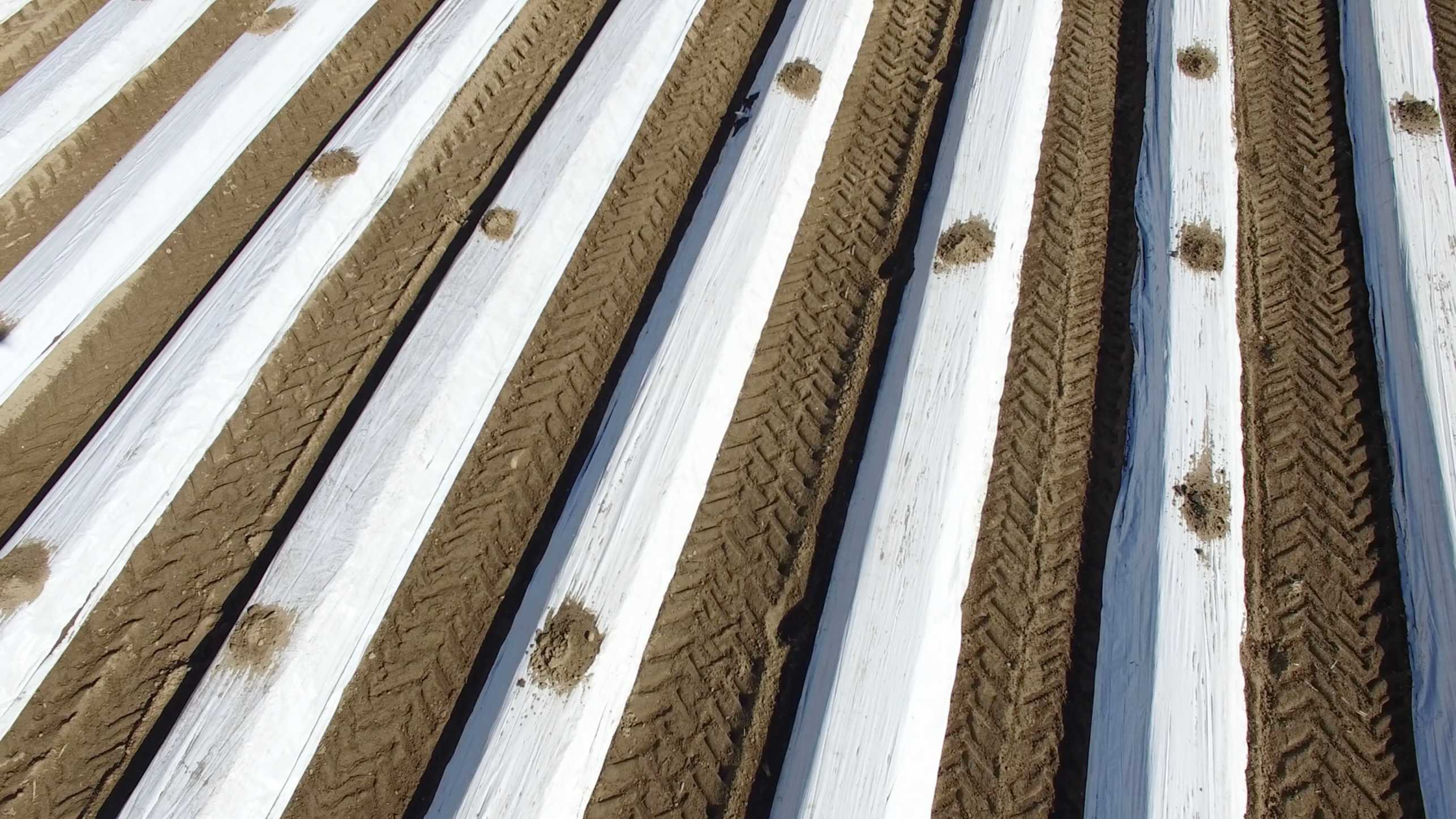
Zumstein, M.T., A. Schintlmeister, T.F. Nelson, R. Baumgartner, D. Woebken, M. Wagner, H.P.E. Kohler, K. McNeill, and M. Sander. Biodegradation of synthetic polymers in soils: Tracking carbon into CO2 and microbial biomass, Science Advances. 2018, 4:eaas9024; DOI: external page10.1126/sciadv.aas9024call_made
Michi (Zumstein)'s last chapter of his PhD thesis was just published in Science Advances. In this work, we determined biodegradation of a synthetic polyester, poly(butylene adipate-co-terephthalate) (PBAT), in an agricultural soil. This work aimed at assess the potential of using PBAT as a biodegradable alternative to polyethylene mulch films in agricultural applications. To study biodegradation, we incubated carbon-13 isotopically labelel PBAT in an agricultural soil. We used the label and state of the art isotope selective analytical techniques to follow the flow of PBAT carbon during biodegradation both into carbon dioxide and microbial biomass.
For more information on this work, please refer to this ETH Zurich news article and this short youtube external pagevideocall_made.
Svenja Agethen's paper on the effect of redox dynamics in the rhizosphere on methane emissions in rewetted peatlands was accepted in Soil Biology and Biochemistry. This work was led by the group of external pageKlaus-Holger Knorrcall_made at the University of Münster and involved some of the electrochemical analyses techniques developed in the Sander group at ETHZ.
Agethen, S., M. Sander, C. Waldemer, K.-H. Knorr. Plant rhizosphere oxidation reduces methane production and emission in rewetted peatlands. Soil Biology Biochemistry, 2018, 125, 125-135; DOI: external page10.1016/j.soilbio.2018.07.006call_made
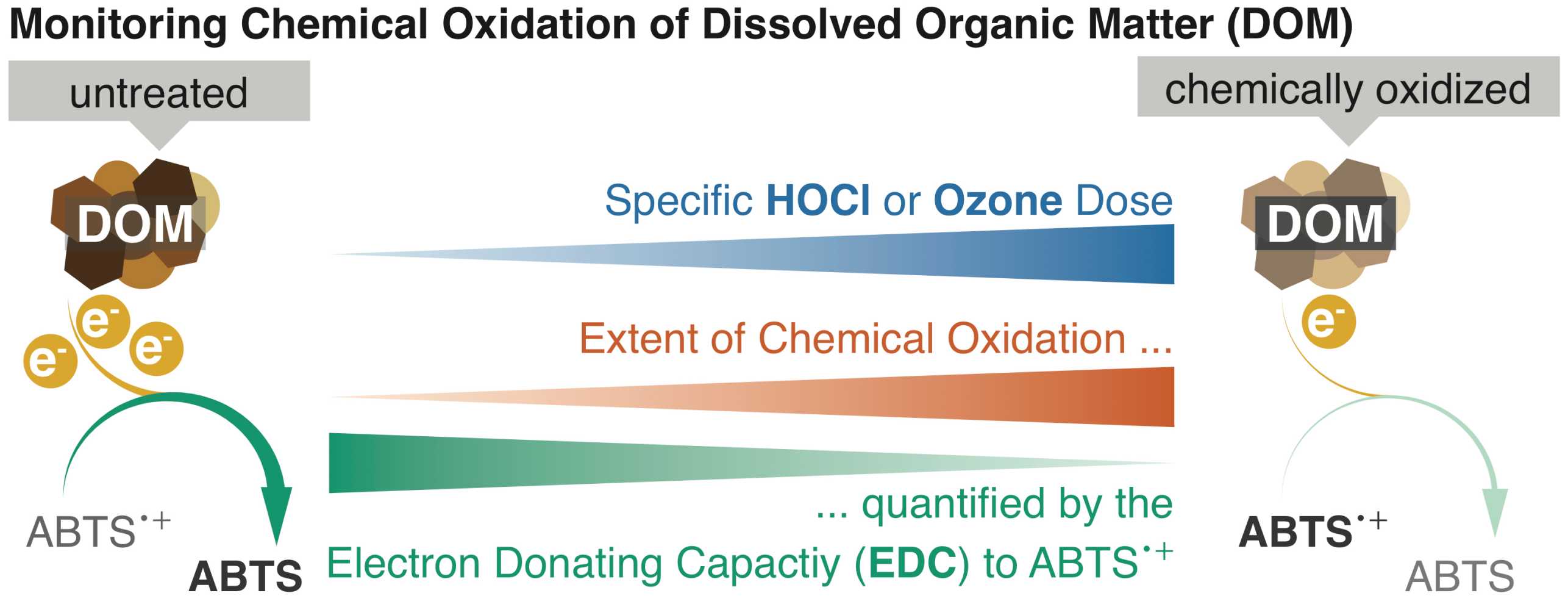
Önnby, L., N. Walpen, E. Salhi, M. Sander, U. von Gunten. Two analytical approaches quantifying the electron donating capacities of dissolved organic matter to monitor its oxidation during chlorination and ozonation. Water Research, 2018, in press; DOI: external page10.1016/j.watres.2018.06.060call_made
Nicola's third PhD research paper (shared first authorship with Linda Oennby from eawag) just was accepted in Water Reseach. Congratulations Nicolas and Linda! The paper compares two analytical methods to monitor changes in the redox state of dissolved organic matter (DOM) during chemical oxidation. Both methods have in common that they quantifying the number of electrons that DOM donates to a chemical oxidant (ABTS°+). The first method is a flow injection analysis system coupled to electrochemical detection. The second method coupled size exclusion chromatography to UV-vis absorbance detection. Both methods yield comparable results.
Nicolas (Walpen) successfully defends his PhD research! His PhD research focussed on the redox properties and dynamics of dissolved and particulate organic matter from Northern Peatlands. He was the first PhD student in the Sander group to have complemented laboratory analyses with work in ombrotrophic bogs in Värmland, Sweden.
On the left you can see Nicolas with external pageRose Corycall_made, who was the external reviewer of Nicola's PhD work, competing in what we refer to as the real PhD defense. Thanks, Rose, for being on the committee and helping to challenge Nicolas during the defense. He did great!
Congratulations, Nicolas ...
... excuse me: Dr. Walpen !
Meret and Michi attend the International Conference 'Interfaces Against Pollution 2018'. Both Meret and Michael gave oral presentations on iron oxide redox chemistry and on the fate of biodegradable polymers in soils, respectively.
The conference took place in external pageLa Grande Mottecall_made, France. The conference dinner was held in a restaurant across from the external pagePont du Gardcall_made. Here the link to the external pageconference webpagecall_made.
Michael (S) was interviewed for an article by the NZZ. The article, written by Uta Neubauer, focusses on (micro)plastic pollution in soils. The article can be found external pageherecall_made (in german only). In this article, Michael refers to the potentials of using biodegradable polymers in agricultural applications as environmentally-friendly alternatives to persistent plastic materials that have a high risk of accumulating in the natural environment.
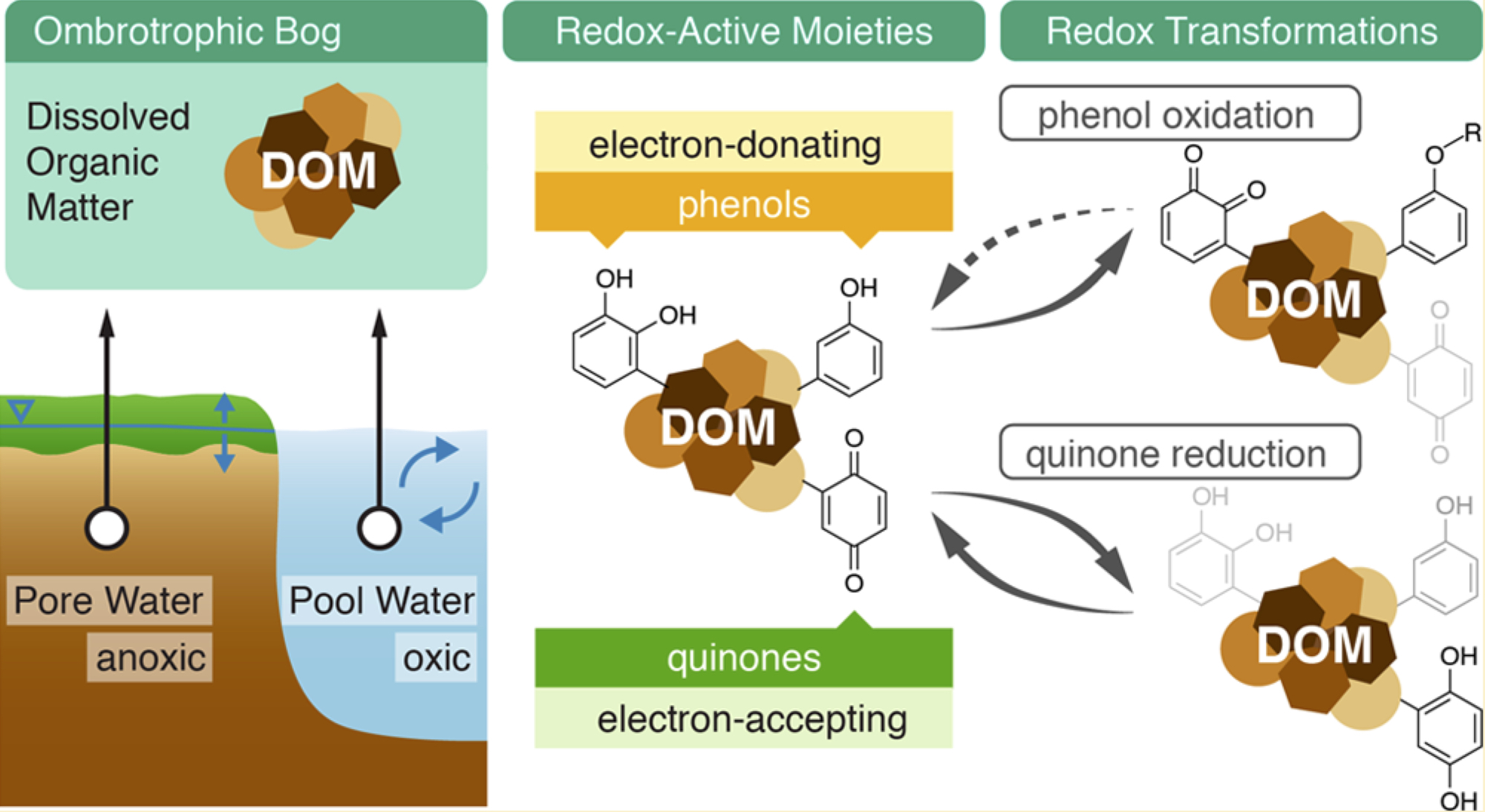
Walpen, N., G. Getzinger, M. Schroth, M. Sander. Electron-donating Phenolic and Electron-accepting Quinone Moieties in Peat Dissolved Organic Matter: Quantities and Redox Transformations in the Context of Peat Biogeochemistry. Environ Sci Technol, 2018, 52, 5236-5245; DOI: external page10.1021/acs.est.8b00594call_made
Nicolas' second paper on the redox properties of peat dissolved organic matter just got published in ES&T. In this work, Nicolas used a flow injection analysis system coupled to electrochemical detection to demonstrate that peat DOM contains both electron accepting quinones and electron donating phenols. He further showed that oxidative processes, occuring either in peatlands or in the laboratory, result in an irreversible loss of electron donating phenols. Finally, Nicolas showed reversible electron transfer to and from electron accepting quinones in DOM, a process that was previously demonstrated only for model DOM isolates.
For our research group, this paper is 'unique' in that it is the first that heavily draws on samples that we collected in field campaigns in ombrotrophic bogs in Värmland Sweden. So, we no longer are just 'lab-rats' :).
Work from a recent collaboration with Guilhem De Hoe and external pageMarc Hillmyercall_made from the University of Minnesota on the synthesis, properties and enzymatic hydrolyzability of polyester elastomers from lactones was accepted for publication in JACS. Congratulations Guilhem!
We contributed to this work, which was led by the Minnesota team, by providing expertise on assessing the enzymatic hydrolyzability of the polyesters. All elastomers, irrespectively of their crosslinking density, were competely hydrolyzable by a cutinase from Fusarium solanii over an environmentally relevant temperature range. This finding supports biodegradation of these elastomers in natural systems.
2017
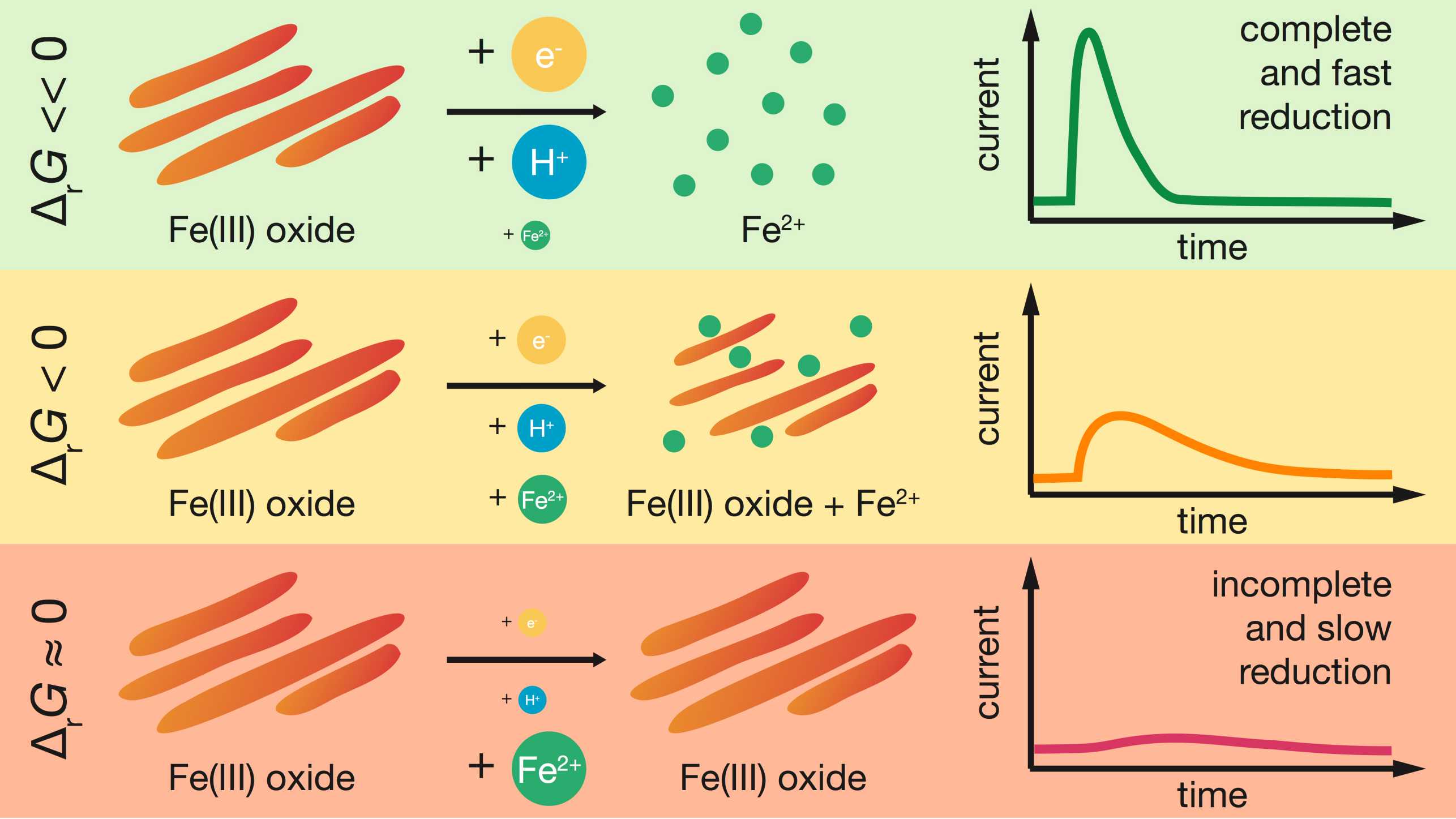
Aeppli, M., A. Voegelin; C. Gorski, T. Hofstetter, and M. Sander. Mediated electrochemical reduction of iron (oxyhydr-)oxides under defined thermodynamic boundary conditions. Environ Sci Technol. 2017. asap, DOI: external page10.1021/acs.est.7b04483call_made
We just got word that a paper from Meret was accepted for publication in ES&T. Congratulations, Meret! In her work, Meret demonstrates that mediated electrochemical analysis can be used to systematically study rates and extents of iron (oxyhydr-)oxide reduction (shown for goethite, hematite and ferrihydrite) as a function of the thermodynamic boundary conditions for oxide reduction. The latter were systematically altered by varying the reduction potential applied to the electrochemical cell, the solution pH and the dissolved Fe2+ concentration in the cell. At intermediate negative free energies for oxide reduction, the natural logarithm of the reaction rate constant linearly correlated with the free energy, strongly suggesting that thermodynamics controlled the rate of reductive oxide dissolution. Meret further showed that the approach can be used to monitor decreases in the reducibility of oxides during transformation of amorphous to more crystalline phases, as shown for the Fe2+-catalyzed transformation of ferrihydrite to goethite.
Work on the enzymatic hydrolysis of PEF polyesters just was accepted in Green Chemistry. This work was led by researchers at the external pageBOKUcall_made in Tulln, Austria. We contributed to this work by conducting quartz crystal microbalance with dissipation monitoring meaurements to assess the rates and extents of enzymatic hydrolysis of selected PEF films.
Weinberger, S., K. Haernvall., D. Scaini, G. Ghazaryan, M.T. Zumstein, M. Sander, A. Pellis, and G.M. Guebitz. Enzymatic surface hydrolysis of poly(ethylene furanoate) thin films of various crystallinities. Green Chem. 2017. asap, DOI: external page10.1039/C7GC02905Ecall_made
Katharina joined our research group as a PhD student. She will be working on an ETH-funded project that focuses on the fate of and stability of novel macromolecular plant incorporated protectants (PIPs) in agricultural soil and water systems. Before coming to ETH, Katharina was a student at the BOKU in the Master program Biotechnology.
Welcome Katharina and great to have you on board!
A feature article on the environmental fate and analytics of Plant-Incorporated Protectants (PIPs) was just accepted in Environmental Science & Technology. In this article, we fighlight knowlegde gaps and identify research opportunities related to understanding the fate of inseticidal PIPs expressed by genetically modified crops (i.e., Cry proteins in Bt crops and double stranded RNA in RNAi crops). As compared to low molecular weight synthetic insecticides used in agriculture, we know very little about these larger macromolecules. Understanding their fate is, however, critical for accurate ecological risk assessment of these now products.
Parker K., and M. Sander. Environmental fate of insecticidal plant-incorporated protectants from genetically modified crops: Knowledge gaps and research opportunities. Environ Sci Technol. 2017. asap, DOI: external page10.1021/acs.est.7b03456call_made
Our video "Carbon Biogeochemistry of Northern Peatlands" is now also featured on the external pageETH youtube channelcall_made. The video has received final edits and a voice over from Gordon Getzinger. Have a look external pagehere.call_made The video provides an overview of our research on carbon cycling in ombrotrophic bogs in Värmland, Sweden. This project is co-lead by Martin Schroth and Michael Sander. The research focusses on understanding processes that govern the release of carbon stored in the bogs to the atmosphere and surrounding water bodies.
Meret and Ashley attended the Goldschmidt 2017 conference in Paris. Both gave oral presentations in the session "Biotic and Abiotic Iron Redox Transformations in Natural and Engineered Systems". Meret's talk entitled Assessing iron oxide reduction using mediated electrochemical analysis presented results of a systematic electrochemical analysis of ferrihydrite, goethite and hematite reduction as a function of the reaction free energy for iron oxide reduction (external pagelinkcall_made to abstract). Ashley's presentation Electrochemical characterization of microbial Fe(III) reduction focused on the use of mediated electrochemical reduction and oxidation to determine rates and extents of reduction of iron by Shewanella oneidensis MR-1 (external pagelinkcall_made to abstract)
The paper focuses on the hydrolysis of different, structurally related 2,5-furan dicarboxylic acid containing polyesters by cutinase 1 from Thermobifida cellulosilytica. The work was led by Dr. external pageDoris Ribitschcall_made and Prof. external pageGeorg Gübitzcall_made at the external pageBOKUcall_made in Vienna. We contributed to this work by conducting enzymatic hydrolysis experiments followed by identification of major hydrolysis products using NMR.
Haernvall, K., S. Zitzenbacher, H. Amer, M. T. Zumstein, M. Sander, K.McNeill, M. Yamamoto, M. B. Schick, D. Ribitsch and G. M. Guebitz. Polyol structure influences enzymatic hydrolysis of bio-based 2,5-furandicarboxylic acid (FDCA) polyesters. Biotechnology Journal, 2017, asap, DOI: external page10.1002/biot.201600741call_madeexternal pagecall_made
Both Meret and Ash presented their recent work at the International Conference on the Biogeochemistry of Trace Elements (ICOBTE) in Zurich, both in the session Effects of iron transformations on the biogeochemistry of trace elements .
Meret's oral presentation Electrochemical analysis of electron transfer to iron(oxyhydr-)oxides: effects of solution pH and reduction potential focussed on the use of mediated electrochemical analysis to link the extents and rates of electron transfer to iron oxides (ferrihydrite, goethite, and hematite) to the free energy of reduction.
Ash's poster presentation Electrochemical characterization of microbial Fe(III) reduction highlighted the unique possibilities of mediated electrochemical analysis to monitor microbial reduction of iron-bearing clay minerals and of iron oxides.
Michael (S.) gave an oral presentation in a symposium on biodegradable mulch films at Novamont in Novara, Italy. The title of the presentation was 'Biodegradation of polyesters in Agricultural Soils.'
The talk provided an overview of our current research efforts to advance a mechanistic understanding of polymer biodegradation in natural environments, including soils. Recent findings were presented addressing the three key steps in polyester biodegradation: microbial colonization of the polyester surfaces, extracellular enzymatic hydrolysis of polyester, and microbial uptale and utilization of low-molecular weight hydrolysis products.
We currenty are on a two week field trip to Värmland, Sweden, to study redox processes in Northern Peatlands. We are conducting experiments in selected ombrotrophic bogs and also collect peat samples to take back to ETH for further analysis.
While the science is exciting, the weather isn't this year. Rain from above, peat water from below. Pick your poison !

We just published a short (5 min) video that describes our research efforts directed towards understanding carbon cycling in northern peatlands. We are interested in these systems because they are a major global pool of terrestrial soil carbon. Our research focusses on assessing the role of redox reactions involving peat particulate and dissolved organic matter on carbon export from these systems in the form of dissolved carbon, carbon dioxide and methane.
We collected the footage for this video with a drone during our 2016 field trip to Värmland, Sweden. The video goes online just two days before leaving again to Sweden for our next sampling campaign.
The video can be watched external pageherecall_made (youtube). Enjoy!
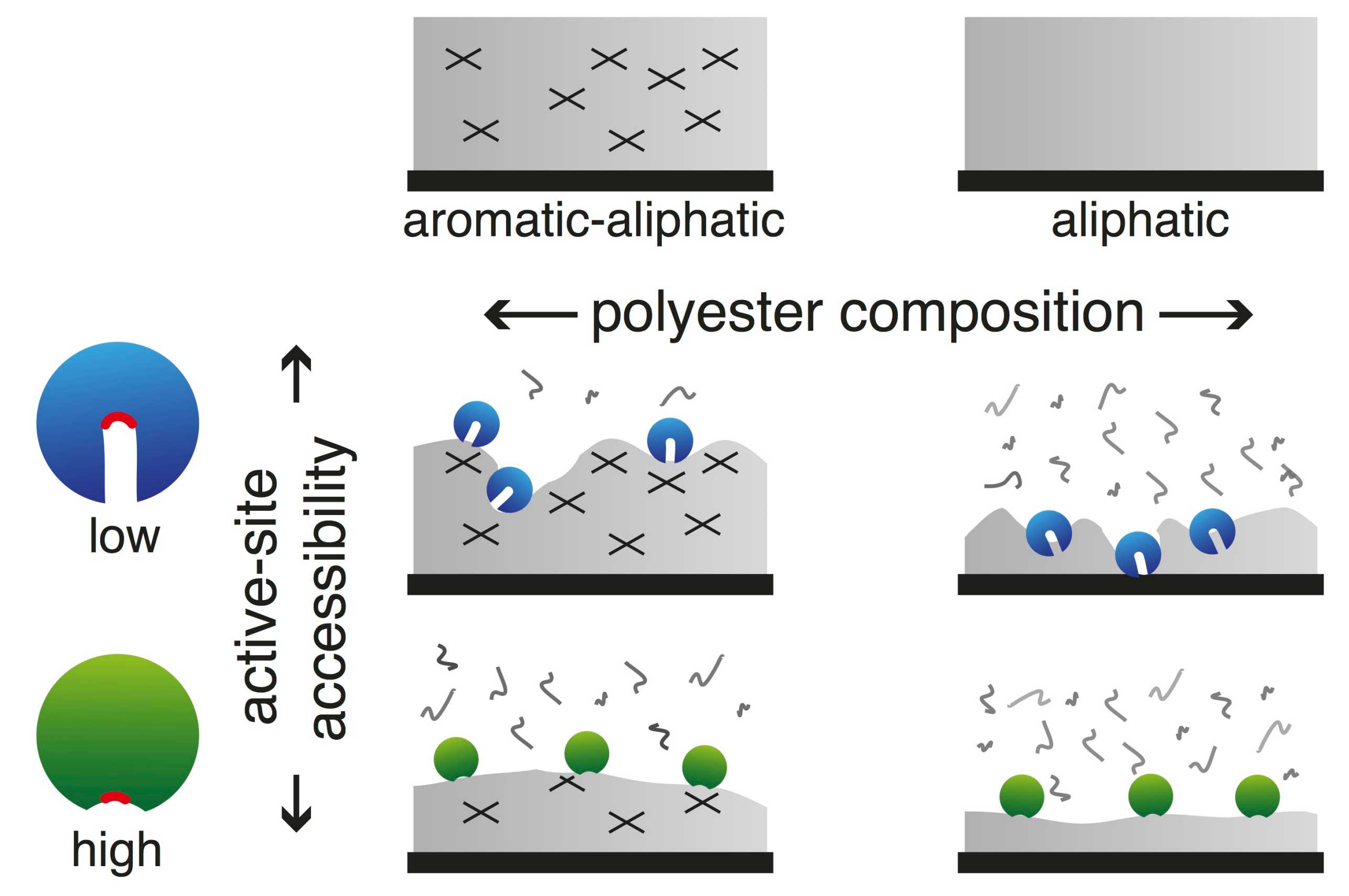
Zumstein, M., D. Rechsteiner, N. Roduner, V. Perz, D. Ribitsch, G. Guebitz, H.-P. Kohler, K. McNeill, M. Sander. Enzymatic hydrolysis of polyester thin films at the nanoscale: effects of polyester structure and enzyme active-site accessibility. Environ. Sci. Technol., 2017, asap, DOI: external page10.1021/acs.est.7b01330call_made
Michi Zumstein's paper on the enzymatic hydrolysis of aliphatic and aliphatic-aromatic polyesters was just accepted in Environ Sci Technol. Congratulations, Michi! In this work, Michi systematically studied the hydrolysis of a set of aliphatic polyesters -varying in the length of the dicarboxylic acid component- and a set of aliphatic-aromatic polyesters -varying in the content of the aromatic diacid component- by a total of eight carboxylesterases using quartz crystal microbalance with dissipation monitoringmeasurements.
The results show that enzymatic hydrolyzability decreases with increasing microcrystallinity of the polyester and with decreasing accessibility of the active site of the carboxylesterase by virtue of their negative effects on the formation of enzyme-substrate complexes. This work successfully links polyester and enzyme structures to hydrolyzability, thereby providing a basis to design polyesters and/or engineer esterases with enhanced hydrolyzability. This information is critical to advance next-generation biodegradable polymers to replace persistent, non-degradable polymers that accumulate in the environment.
A study on the enzymatic hydrolysis of aromatic and aliphatic polyesters, including poly(ethylene terephthalate) (PET), by Thermobifida cellulosilytica Cutinase 1 expressed in Pichia pastoris was accepted in Frontiers in Microbiology. This work was led by external pageDr. Alessandro Pelliscall_made and external pageProf. Georg Gübitzcall_made at the external pageUniversity of Natural Resources and Life Sciencescall_made in Vienna, Austria. We contributed to the study by assessing the enzymatic hydrolysis of thin films of poly(3-hydroxybutyrate-co-3-hydroxyvalerate (PHBV) and poly(butylene succinate) (PBS) by Thermobifida cellulosilytica Cutinase 1 using a recently-published approach based on quartz crystal microbalance with dissipation monitoring (QCM-D) measurements.
Gamerith, C., M. Vastano, S. Ghorbanpour, S. Zitzenbacher, D. Ribitsch, M.T. Zumstein, M. Sander, E.H. Acero, A. Pellis, and G. M. Gübitz. Enzymatic Degradation of Aromatic and Aliphatic Polyesters by P. pastoris-expressed Cutinase 1 from Thermobifida cellulosilytica. Frontiers in Microbiology. 2017, DOI: external page10.3389/fmicb.2017.00938call_made
Michael attends the European Geosciences Union (EGU) General Assembly in Vienna. He will give a talk on Electron transfer properties of peat organic matter: from electrochemical analysis to redox processes in peatlands in the session Biogeochemistry of Peatlands and Lakes organized by Nigel Roulet. This session is organized in memory of external pageProf. Dr. Christian Blodaucall_made. Christian's research on the redox properties of peat organic matter was very (!) influential on the work that we conduct in this area. His work motivated many of the analytical method developments that we worked on over the past years. In fact, without Christian's work, we may have never made it out of the laboratory and into peatlands. While the circumstances for this session are truely saddening, I am looking forward to the science presented and to meeting some of Christian's close collaborators.
A paper on the electron donating capacities of dissolved sulfide and dissolved organic matter in sediment pore waters of external pageprarie potholescall_made was just accepted in ESPI. This work was let by Grant Wallace and external pageBill Arnoldcall_made at the University of Minnessota. Congratulations! In this paper, we compared two experimental approaches to quantify the electron donating capacities of dissolved reduced porewater constituents: (i) the reductive transformation of nitroaromatic compounds with different ring substituents and (ii) the reduction of the radical cation of 2,2'-azino-bis(3-ethylbenzothiazoline-6-sulphonic acid) (i.e., ABTS°+) in mediated electrochemical oxidation. Similar capacities were obtained by both approaches. Furthermore, sulfide was identified as the major reductant in these systems.
Wallace, G., M. Sander, Y.-P. Chin, and W.A. Arnold. Quantifying the electron donating capacities of sulfide and dissolved organic matter in sediment pore waters of wetlands. Environmental Sciences: Processes & Impacts. 2017, DOI: external page10.1039/C7EM00060Jcall_made
Meret was awarded with one of this years external pageChemistry Travel Awardscall_made granted by the 'Platform Chemistry' of the Swiss Academy of Sciences (external pageSCNATcall_made), the Swiss Chemical Society (external pageSCScall_made), and the Swiss Society for Food Chemistry (external pageSSFCcall_made). The award is for the upcoming Goldschmidt 2017 Conference in Paris (August 13th - 18th, 2017).
Congratulations, Meret !
Michi Zumstein's paper on enzymatic polyester hydrolysis made it on the cover of ES&T. In this paper, Michael introduces a sensitive and high-throughput method to study enzymatic polyester hydrolysis. The method is based on monitoring the co-hydrolysis of a fluorogenic ester probe embedded into the polyester matrix. The cover shows an artists' view on this hydrolysis process depicting the polyester strands (grey ribbons), carboxylesterase molecules (larger blue spheres), the fluorogenic probe fluorescein dilaurate (dark green spheres with two grey bars), and the fluorescent product, fluorescein (green sphere) (external pageElla Maru Studiocall_made). In the paper, the novel method was validated by monitoring the rates and extents of hydrolysis of a set of aliphatic polyesters by two enzymes, Rhizopus oryzae lipase and Fusarium solani cutinase.
M.T. Zumstein, H.-P. E. Kohler, K. McNeill, and M. Sander. High-throughput analysis of enzymatic hydrolysis of biodegradable polyesters by monitoring co-hydrolysis of a polyester-embedded fluorogenic probe. Environ Sci Technol. 2017. asap, DOI: external page10.1021/acs.est.6b06060call_made
Kim presents on her current work on the environmental fate of double stranded RNA. This class of biomolecules are used as insecticidal biopesticides in the newest generation of genetically modified RNA interference crops (e.g., see external pageherecall_made).
Chiheng presents on the production of hydrogen peroxide during the oxidation of reduced natural organic matter by oxygen. While this reaction has received little attention, it may be key to the formation of reactive oxygen species at anoxic-oxic interfaces in systems containing organic matter.

The image in the buttom center shows one of the peatlands that were sampled in July 2014 and 2016.
Here a external pagelinkcall_made to an editorial comment by David Sedlak on the best papers. Yes, we eat lots of chocolate (rich of phenolic antioxidants)!
Walpen, N., M. Schroth, M. Sander. Quantification of phenolic antioxidant moieties in dissolved organic matter by flow-injection analysis with electrochemical detection. Environ Sci Technol, 2016, 50, 6423-6432;DOI: external page10.1021/acs.est.6b01120call_made
Nicolas' paper introducing a flow injection analysis system coupled to electrochemical detection to quantify phenolics in dissolved organic matter was awarded the best Environmental Technology Paper 2016 by the editors of ES&T. Congratulations, Nicolas. Besides introducing the technology, Nicolas applied the technique to determine total phenol contents in the pore waters and pool waters collected in ombrotrophic bogs in Värmland, Sweden. This work was motivated by the fact that phenolic compounds are believed to have inhibitory effects on microbial and enzymatic activities and thus are critical to slow organic matter turnover and hence carbon storage in these systems. Introducing oxygen to peatlands (e.g., during more frequent dry periods in a warming climate) may trigger oxidative removal of the phenolic compounds (which the technology can follow, as shown in the paper), resulting in decreased inhibition and thus ultimately carbon release from these systems.
More information on the publication can be found here.
We also congratulate Kimberly Parker and Bill Mitch for winning the best Environmental Science Paper 2016 ! We are lucky to now have Kim as a postdoctoral researcher in our group at ETH :).
Alwina's paper on redox properties of clay-rich sediments was accepted in Chemical Geology. Congratulations, Alwina. This work was conducted at the University of Utrecht in the group of Thilo Behrends and employed mediated electrochemical reduction and oxidation to quantify the electron donating and accepting capacities of redox active geochemical phases in a subsurface Boom clay formation. This work shows that the electrochemical methods provide an integrative measure of the redox active constituents in these sediments and that their relative contributions can be estimated from the rates of electron transfer.
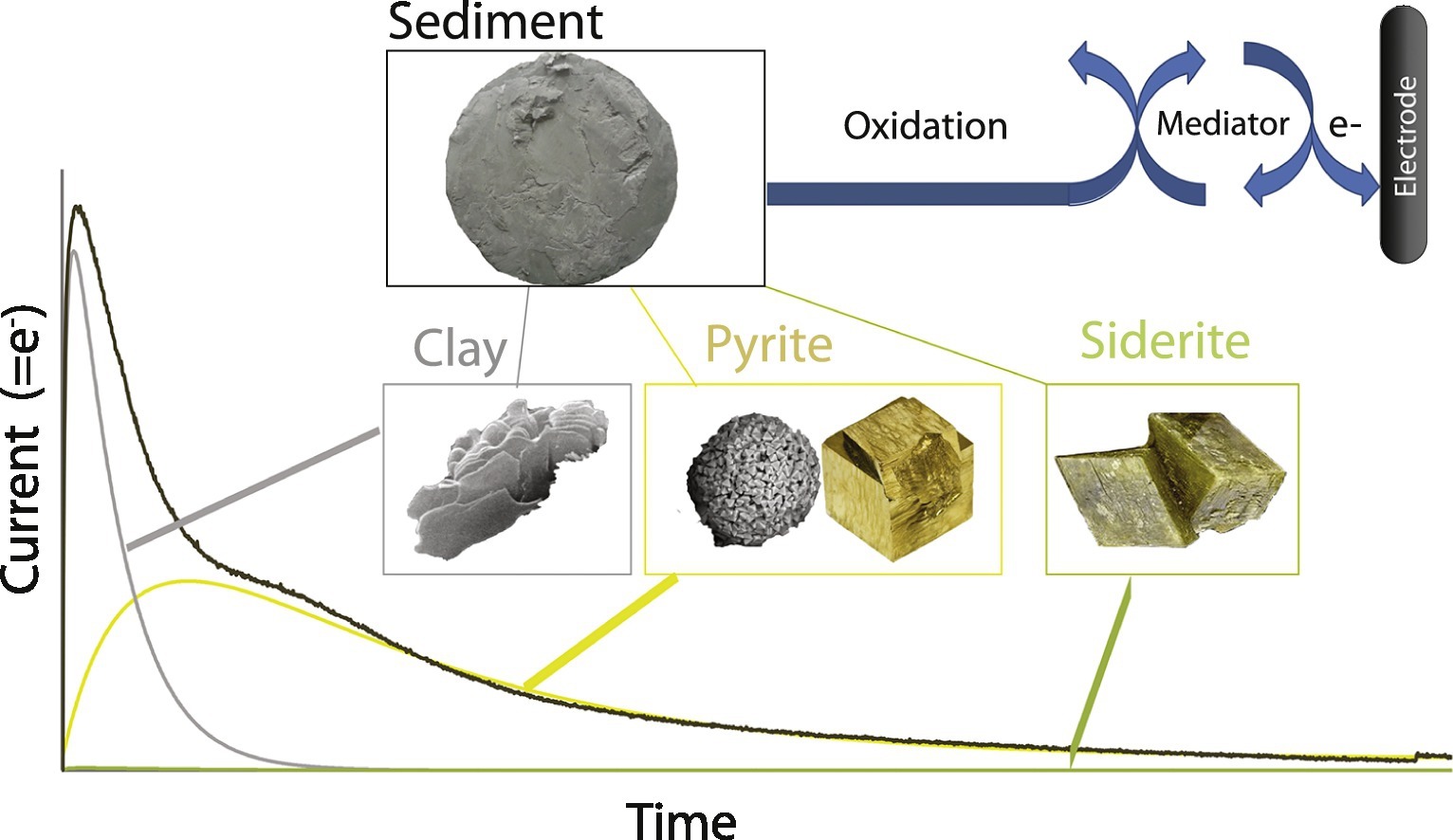
Hoving, A. L., M. Sander, C. Bruggeman, T. Behrends. Redox properties of clay-rich sediments as assessed by mediated electrochemical analysis: Separating pyrite, siderite and structural Fe in clay minerals. Chemical Geology, 2017, asap; external pageDOI:10.1016/j.chemgeo.2017.03.022call_made
Kim attends the iPlanta Conference in Rome that was organized as a kick-off event for the iPlanta COST action of the EU. Kim presented on the 'Environmental fate of double-stranded RNA (dsRNA): Mechanistic studies on dsRNA adsorption and degradation in laboratory systems'. Kim is a Marie Curie Fellow in our research group working on the environmental chemistry of dsRNA in coollaboration with Dr. Bogdan Mateescu from the RNA Biology group here at ETHZ.
A new brochure for the Major in Biogeochemistry and Pollutant Dynamics within the Master in Environmental Sciences just got published. We were excited to find that one photograph taken during one of the field trips to Sweden was selected for the cover art of the brochure (see on the right; Kurt and myself at the edge of a pond in July 2014).
To our defense: no, we are not fishing! Instead, we are collecting water samples from a pool in an ombrotrophic bog. We later analyzed the dissolved organic matter in the pool water for its electron donating capacity (external pagesee herecall_made). But yes, we used an old fishing rod in that process. Its true, no alternative facts!
The second paper of Michael Zumstein's PhD work was just accepted for publication in Environmental Science and Technology. In this work we introduce a novel analytical approach to study enzymatic polyester hydrolysis that is based on the enzymatic co-hydrolysis of fluorescein dilaurate, a fluorogenic ester probe, pre-embedded into the polyester matrix. Implemented on a microplate reader platform, this approach enables sensitive and high-throughput analysis of enzymatic polyester hydrolysis, as demonstrated for eight aliphatic polyesters and two fungal esterases. The results show that this approach can be used to provide mechanistic insights into the hydrolysis processes as well as to screen for esterases competent of hydrolyzing polyesters. This work is part of a larger effort in our group to understand the environmental fate of biodegradable polyesters in soils. These biodegradable polymers have the potential to replace persistent polymers in numerous applications and thereby can help to reduce the accumulation of plastic materials in the environment.
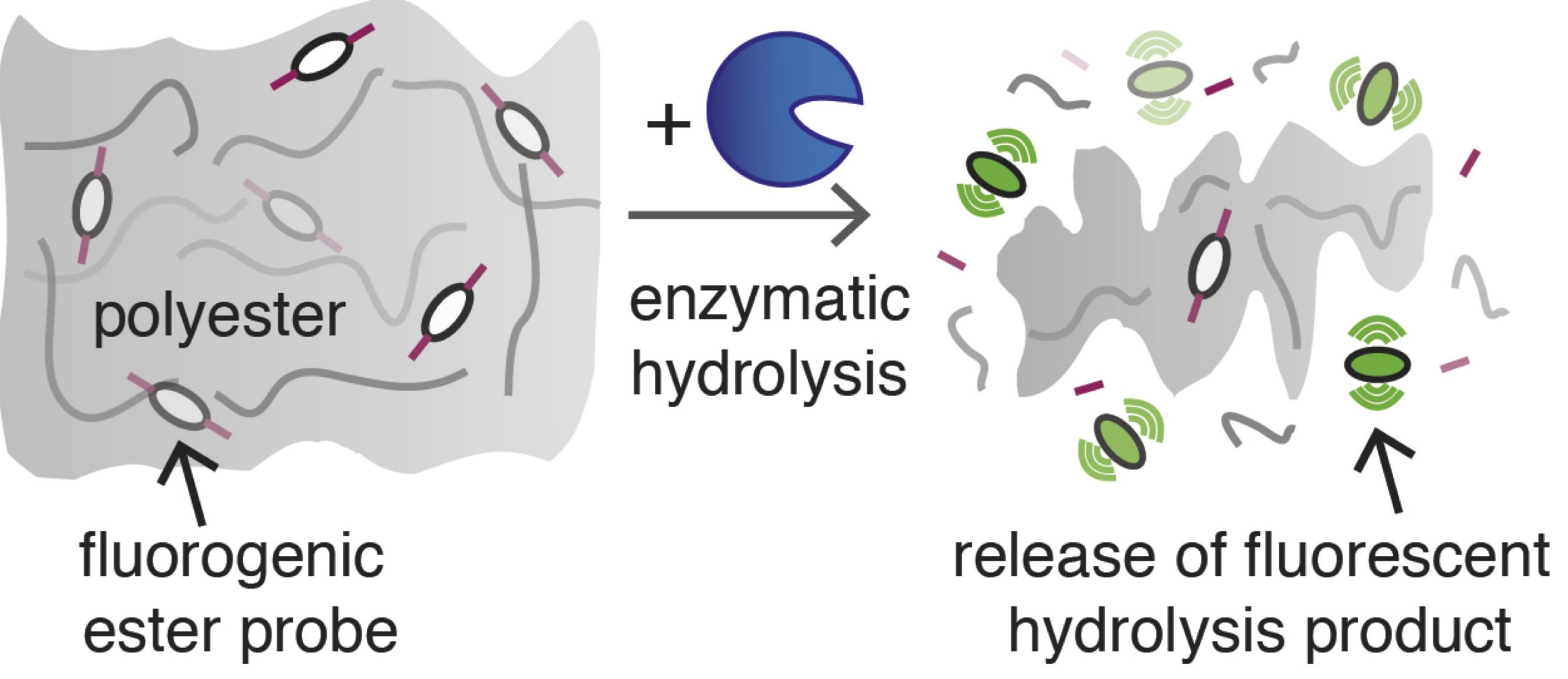
M.T. Zumstein, H.-P. E. Kohler, K. McNeill, and M. Sander. High-throughput analysis of enzymatic hydrolysis of biodegradable polyesters by monitoring co-hydrolysis of a polyester-embedded fluorogenic probe. Environ Sci Technol. 2017. asap, DOI: external page10.1021/acs.est.6b06060call_made
By invitation of the group of Prof. external pageThilo Hofmanncall_made, I visited the Department of Environmental Geosciences at the University of Vienna and gave a seminar talk entitled Environmental Chemistry of (Bio-) Macromolecules: Joys and Tribulations!
I had a very good time in Vienna and enjoyed the meetings and discussions with the members of Thilo Hofmann's group, Stefan Krämer's group and other groups and collaborators at the Univeristy of Vienna and at the BOKU. Thanks for the invitation!
2016
Really exciting news: René just stopped by my office to drop off a copy of the new (=3rd) edition of the Environmental Organic Chemistry textbook. Judging from the weight alone it will be another classic !
Congratulations René and Phil and Dieter to the new edition. I will work hard to include the new content already in my classes next year. More information on the book external pageherecall_made. Perfect Christmas present for friends and family also! :)
Meret attends the Swiss Geoscience Meeting in Geneva and contributes a talk in the session Environmenal Biogeochemistry of Trace Elements entitled: Reduction dynamics if iron (oxyhydr-)oxides as assessed by mediated electrochemical analysis. The full program of the meeting can be found external pagehere.call_made
Michael (Sander) attends 1st Management Committee Meeting of the COST Action 'Modifying plants to produce interfering RNA' in Brüssels. The cost action brings together researchers that work on various aspects of a new generation of transgenic plants based on external pageRNA interferencecall_made (i.e., RNAi crops). Kim (Parker) and Michael joined this action to contribute to the environmental fate and risk assessment of double stranded RNAi in the environment, including soils.
More information on the action can be found external pageherecall_made.
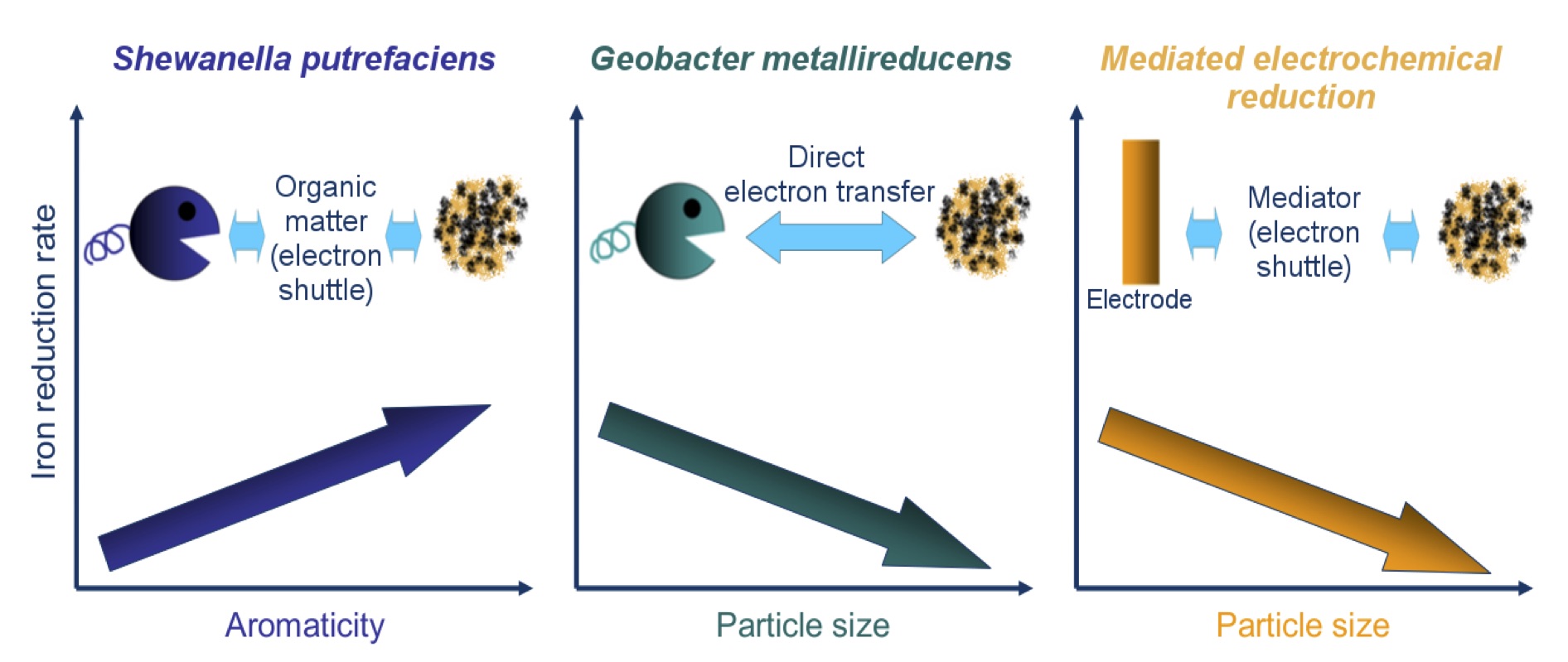
Poggenburg, C., R. Mikutta, M. Sander, A. Schippers, A. Marchanka, R. Dohrmann, G. Guggenberger. Microbial reduction of ferrihydrite-organic matter coprecipitates by Shewanella putrefaciens and Geobacter metallireducens in comparison to mediated electrochemical reduction. Chemical Geology, 2016, asap; DOI: external page10.1016/j.chemgeo.2016.09.031call_made
Christine (Poggenburg) just got note that her external pagepapercall_made on microbial and electrochemical reduction of Fe-organic matter (OM) coprecipitates got accepted in Chemical Geology. Christine's work, conducted at the Insitute of Soil Science at the Leipniz University of Hanover under the lead of external pageRobert Mikuttacall_made and external pageGeorg Guggenbergercall_made, assessed the rates and extents of microbial reduction of different Fe-OM coprecipitates. Both Shewanella putrefaciens and Geobacter metallireducens were used as model iron reducing bacteria. This work was complemented by mediated electrochemical reduction of the Fe-OM specimen that Christine conducted in our group here at ETH Zurich. The work shows that OM may affect the reduction dynamics of Fe-OM coprecipitates in various ways: besides affecting reduction by providing electron shuttling moieties, OM may also alter reduction dynamics by impacting the aggregate sizes of Fe-OM coprecipitates. Both chemical and physical effects thus need to be taken into account in in future work directed towards understanding the reduction dynamcis of Fe-OM coprecipitates. Congratulations Christine!
Meret and external pageAshcall_made both present parts of their current work on iron oxide redox chemsiry at the 2nd European Mineralogical Conference (external pageemc2call_made) in Rimini, Italy. The titles of their talks are "Reductive dissolution of iron (oxyhydr-)oxides as assessed by mediated electrochemical analysis" and "Electrochemical characterization of microbial Fe(III) reduction". This work is part of a SNF-funded project on the redox properties and dynamics of iron oxides and iron-bearing clay minerals granted to external pageThomas Hofstettercall_made and Michael Sander. The presented work was/is conducted in collaboration with external pageAndreas Vögelincall_made and external pageChris Gorskicall_made.
I visited the Helmholtz Centre for Environmental Research - UFZ in Leipzig, Germany, for the first time (somewhat unbelievable, after more than 10 years of working in the environmental sciences)! Besides giving a seminar talk on the fate and reactivity of (bio)macromolecules in natural and engineered systems, I had the opportunity to catch up with former colleagues (Kai-Uwe Goss and Martin Krauss) as well as to personally meet and discuss science with a number of researchers at UFZ. I had a very good and interesting time, thanks for the invitation!
The photo shows the mosaic "Kernspaltung" (1959; Bert Heller) that can be found in the entrance of the former building of the Institute of Applied Radiology, now part of the overall building complex of the UFZ.
Michael attended the 9th International Conference on Interfaces Against Pollution (external pageIAP2016call_made) that took place in Lleida, Spain. Michael's talk entitled Viruses at solid-water interfaces: assessing major interactions driving adsorption and competitive effects on adsorption in the presence of dissolved organic matter as co-adsorbate contained highlights from the PhD work of Tony (external pageAntonius Armaniouscall_made), now at Chalmers in Sweden. This project was conducted in collaboration with external pageTamar Kohncall_made at EPFL.
In his doctoral examination, Chiheng successfully defended his PhD thesis work entitled: Aquatic Photochemistry of Amino Acids and Oligopeptides.
The examination was taken by Kris McNeill, Tamar Kohn from EPFL, and myself. Kris was the primary supervisor of Chiheng's work. I had the pleasure to coadvise Chiheng on some projects.
祝贺, great job Chiheng ... sorry: Dr. Chu !
谁这么聪明,考试考得真棒!
Rachel's paper on the photochemistry of the nonribosomal peptide bacitracin made it onto this week's cover of Environmental Science & Technology. Congratulations Rachel!
Lundeen, R.A., C. Chu, M. Sander, and K. McNeill. Photooxidation of the antimicrobial, nonribosomal peptide bacitracin A by singlet oxygen under environmentally relevant conditions. Environ Sci Technol.; 2016, 50, 8586-8595. DOI: external page10.1021/acs.est.6b01131call_made
external pageChris Gorskicall_made and his group at Penn State just had their new and exciting work on the thermodynamics of goethite and hematite in oxide - Fe2+ systems accepted in ES&T. Chris and his students nicely demonstrate that the redox potentials of these systems can be accurately determined by mediated potentiometric measurements, a novel approach to study the redox properties of redox-active geochemical phases. While previously applied successfully to natural organic matter and iron bearing clay minerals, this is the first study to show that the technique is applicable to oxide minerals. Chris and his students find perfect agreement between their measured data (collected in systems that were systematically varied in both pH and the dissolved Fe2+ concentration) with redox theory and with previously reported thermodynamic data for goethite and hematite.
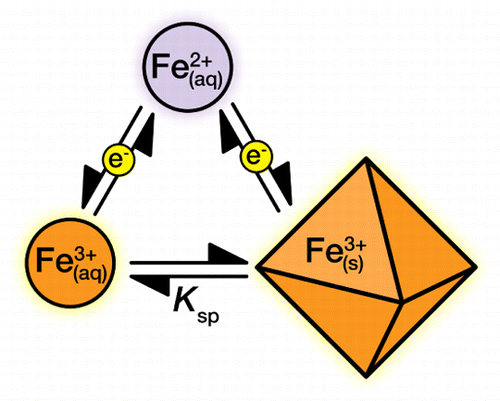
Gorski, G., R. Edwards, M. Sander, T.B. Hofstetter, and S. M. Stewart. Thermodynamic Characterization of Iron Oxide-Aqueous Fe2+ Redox Couples. Environ Sci Technol, 2016, asap; external pageDOI:10.1021/acs.est.6b02661call_made
Michael Zumstein has attended and presented at the international conference "Enzymes in the Environment: Ecology, Activity & Applications" in Bangor, Wales. Michael presented part of his PhD research on the enzymatic hydrolysis of polyester thin films. For his contribution Enzymatic Hydrolysis of Polyester Films Investigated by Novel Approaches, Michael was awarded with one of the PhD travel grants by the conference organizers.
As part of an SNF-funded project on the occurrence and dynamics of phenolic substances in northern peatlands, we went onto an extensive field trip to Värmland to collect peat porewater samples from a number of ombrotrophic bogs. The group included members of the Sander subgroup (Nicolas, Gordon, Taylor and Michael S), Martin Schroth (head of the Subsurface Biogeochemistry group), Annika (who is conducting her PhD research in the Environmental Microbiology group of Mark Lever) Max (a PhD candidate at the IGB Berlin) and Stefan (a technician at ETH aka MacGyver). Besides long days of sampling, we also enjoyed the ourdoors, swimming, and fishing.
The foto on the right shows Taylor, Gordon and myself during sampling on one of the more rainy days.
Kim Parker joined the research group as a postdoctoral research on an Individual Marie Sklodowska-Curie fellowship. Kim will be working on the fate and stability of genetic materials in agricultural soil and water systems, thereby extending on her expertise on the fate and stability of biomacromolecules in natural systems that she acquired during her PhD studies at Yale and Stanford University. More information on Kim can be found here. Welcome Kim and great to have you with us.
Three PhD students from the Environmental Chemistry Group participated in this year's GRC - Environmental Sciences: Water conference in New Hamsphire: Nicolas Walpen, Michael Zumstein, and Chiheng Chu. All three had poster contributions presenting the newest results of their PhD research.
Nicolas' poster on the electrochemical quantification of phenols in peat porewaters using flow injection analysis coupled to electrochemical detection was selected for a poster award. Congratulations, Nicolas!
Gordon Getzinger recently joined our research group as a postdoctoral researcher after completing his PhD at Duke University, USA. As part of the SNF-funded project on the occurrence and dynamics of low molecular weight phenolic substances in peatlands, Gordon will spearhead efforts to characterise and quantify phenolic compounds in peat porewaters. Leveraging his experience in high-resolution accurate-mass mass spectrometry, Gordon hopes to inform a holistic understanding of the role of phenolic compounds in the organic carbon cycling of northern peatlands. More information on Gordon can be found here. Welcome Gordon and great to have you on board!
Nicolas paper introducing a novel analytical method -- flow-injection analysis coupled to chronoamperometric detection -- to quantify phenolic antioxidant moieties in dissolved organic matter (DOM) has been accepted for publication in ES&T. The method relies on reacting DOM with a one-electron chemical oxidant, ABTS°+, followed by the subsequent electrochemical detection of the reduction of ABTS°+ to ABTS. This method has unprecedented sensitivity, allows for the quantification of electron donating phenols in natural and dilute (i.e., low DOM) samples, has automated sample injection, and is field portable. Furthermore, Nicolas' paper is the first from our group in which we report on the redox properties of natural peat DOM that we collected in ombrotrophic bogs in Sweden: not only does the new method allow to analyze these samples (which, in fact, had to be diluted for analysis !), the method is further capable of following the enzymatic oxidation of the DOM-phenols by laccase, a phenol oxidase. The work was conducted in collaboration with Prof. Martin Schroth. Great job and congratulations, Nicolas!
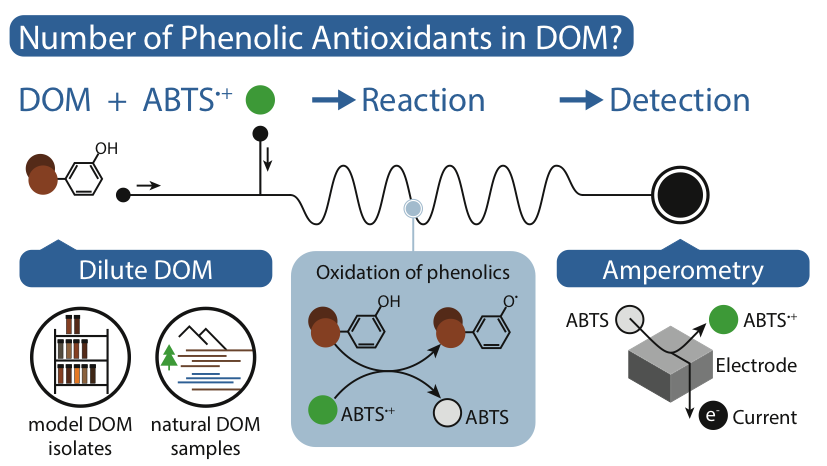
Walpen, N., M. Schroth, M. Sander. Quantification of phenolic antioxidant moieties in dissolved organic matter by flow-injection analysis with electrochemical detection. Environ Sci Technol, 2016, asap; DOI: external page10.1021/acs.est.6b01120call_made
Michael Zumstein was awarded a PhD travel stipend to attend the conference "Enzymes in the Environment: Activity, Ecology & Applications" to be held in Bangor, Wales, 14-18th July, 2016. Michael's contribution will focus on the enzymatic hydrolysis of snythetic polyester polymers in soils and water. More information on the conference can be found external pageherecall_made. Congratulations, Michi!
Rachel's paper on the photochemical transformation of bacitracin was accpeted in Environ Sci Technol. This work was led by Rachel and Kris. Here is what external pageKriscall_made wrote in his news section: "Rachel Lundeen's external pagepapercall_made on the photochemistry of bacitracin A appeared online in Environmental Science & Technology today. There are a couple of aspects that make this paper special for us. It is our first paper of what we hope will be a series on the photochemistry of external pagenonribosomalpeptidescall_made, a class of important natural products that have been very poorly studied from a photochemical perspective. This paper also represents an analytical milestone for us, as mass spectrometric analysis of the products is made challenging by the cyclic peptide structure. Finally, bacitracin is a widely used antibiotic whose environmental fate is largely unknown."
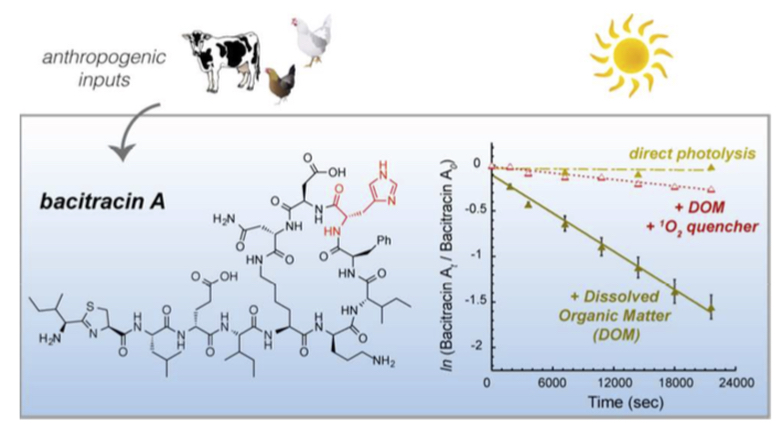
Lundeen, R.A., C. Chu, M. Sander, and K. McNeill. Photooxidation of the antimicrobial, nonribosomal peptide bacitracin A by singlet oxygen under environmentally relevant conditions. Environ Sci Technol.; asap. DOI: external page10.1021/acs.est.6b01131call_made
Michael (Zumstein) was awarded with one of this years external pageChemistry Travel Awardscall_made granted by the 'Platform Chemistry' of the Swiss Academy of Sciences (external pageSCNATcall_made), the Swiss Chemical Society (external pageSCScall_made), and the Swiss Society for Food Chemistry (external pageSSFCcall_made). The award is for the upcoming Gordon Research Conference external pageEnvironmental Sciences: Watercall_made in New Hamsphire, USA (June 26 - July 1, 2016).
Congratulations, Michael !
Max's second paper on redox dynamics in lake sediments was accepted in Environmental Chemistry. This work, led by Max and his colleagues at the Leibniz-Institute of Freshwater Ecology and Inland Fisheries (external pageigbcall_made), is the first to combine mediated electrochemical analysis of particulate geochemical phases with the analysis of dissolved redox-active species to integratively quantify changes in the redox states in lake sediment materials under alternating oxygen availabilities. While the work focussed on mesocosm incubation experiments in the laboratory, the collected data was discussed in the context of hypolimnetic oxygen fluctuations in the lake from which the sediment mesocosms were obtained. The results of this work demonstrate that particulate geochemical phases play an important role in sediment electron fluxes and that mediated electrochemical reduction and oxidation are powerful analytical techniques to quantify electron transfer to and from these phases. Congratulations, Max!
The picture on the right shows Max and Michi during a field trip to Sweden in the summer of 2014.
Lau, M., M. Sander, J. Gelbrecht, M. Hupfer. Spatiotemporal redox dynamics in a freshwater lake sediment under alternating oxygen availabilities: combined analyses of dissolved and particulate electron acceptors. Environmental Chemistry, 2016, external pageasapcall_made
Armanious, A., M. Münch, T. Kohn, and M. Sander. Competitive co-adsorption dynamics of viruses and dissolved organic matter to positively charged sorbent surfaces. Environ Sci Technol, 2016, 50, 3597-3606; DOI: external page10.1021/acs.est.5b05726call_made
Tony's second paper on virus adsorption to solid-water interfaces has been accepted in Environ Sci Technol. Congratulations, Tony! In this paper, Tony systematically assessed competitive co-adsorption dynamics of dissolved organic matter and one of four bacteriophages (MS2, fr, GA, and Qb) or negatively charged nanospheres to positively charged sorbent surfaces. While all viruses directly competed with the DOM for adsorption sites, the effects of competition on overall virus adsorption strongly depended on the interactions of viruses with DOM adlayers that formed on the sorbent surface: DOM competitively suppressed adsorption of MS2 and fr because these two viruses did not adsorb to DOM adlayers. Similar results were obtained for the negatively charged nanospheres. Conversely, adsorption of GA and Qb was only modulated in the presence of DOM because these two viruses adsorbed to DOM adlayers. The experimental data of MS2-DOM competition was complemented by calculations using a random sequential adsorption model. This model accurately described the experimental data when accounting for unfolding of DOM on the surface of the adsorbent. Overall, this paper provides a more fundamental understanding of competitive coadsorption of DOM and negatively charged biomacromolecules and nanoparticles. This paper is the result of a collaborative external pageSinergiacall_made project with external pageTamar Kohncall_made at EPFL.
2015
The last entry of this year is dedicated to the most exciting "news" of 2015!
You can see it glow in the dark on the left.
More won't be revealed. And no, it is not a fusion reactor ... it is much more exciting than that!
I also chose this picture as my Christmas Holiday Greeting Card to all of you.
Merry Christmas ...
and have a good start into 2016!
Laura handed in her dissertation (Diss.-No. ETH 22931) entitled
Redox Properties and Dynamics of Natural Organic Matter as assessed by Mediated Electrochemical Analysis.
The written thesis was accepted and Laura may now be officially addressed as "Dr. Klüpfel"!
Congratulations, Laura !
... and thanks for the last four years that we worked together.
This picture shows Laura and Nicolas in external pageKnuthöjdsmossencall_made making fun of a red neck duck with yellow legs (aka their "boss" ... but that is a different story).
Tony's first paper on virus adsorption to solid-water interfaces has been accepted in Environ Sci Technol. In his work, Tony studied the adsorption rates and final extents of four bacteriophages (MS2, fr, GA, and Qb) to several model surfaces, including DOM adlayers, as a function of solution pH and ionic strength. The viruses and surfaces where chosen to cover a range of polarity and charge characteristics. The work highlights the importance of electrostatic interactions and the hydrophobic effect to virus adsorption. The importance of these interactions were supported both by experimental data as well as by modeling the charge and polarity characteristics of the virus capsids. This paper is the result of a collaborative external pageSinergiacall_made project with external pageTamar Kohncall_made at EPFL. Congratulations, Tony, for this exceptionally comprehensive paper!
Armanious, A., M. Aeppli, R. Jacak, D. Refardt, T. Sigstam, T. Kohn, and M. Sander. Viruses at solid-water interfaces: A systematic assessment of interactions driving adsorption. Environ Sci Technol, 2016, 50, 732-743 DOI: external page10.1021/acs.est.5b04644call_made
M.T. Zumstein; H.P. E Kohler, K. McNeill, and M. Sander. Enzymatic hydrolysis of polyester thin films: real-time analysis of film mass changes and dissipation dynamics. Environ Sci Technol, 2016, 50, 197-206, DOI: external page10.1021/acs.est.5b04103call_made
Michi Z's first paper just got accepted in Environmental Science and Technology! This paper focusses on the enzymatic hydrolysis of polyester thin films as assessed by quartz crystal microbalance with dissipation monitoring (QCM-D) measurements. This novel analytical approach allows monitoring film mass changes and dissipation dynamics in real-time and label-free at a very high sensitivity (i.e., mass changes in the ng/cm2 range are detectable). In this paper, Michi systematically studied the effects of solution pH and temperature on the hydrolysis of poly(butylene succinate) -a commercially important biodegradable polyester- by the lipase of Rhizopus oryzae (RoL), a fungus found in soils. The versatility of the QCM-D based approach was demonstrated by analyzing the hydrolysis of additional polyesters by RoL. This work is part of a larger effort in our group to understand the factors that govern the fate of biodegradable polyesters in soils (as well as other natural systems).
This study, led by external pagecolleaguescall_made at the external pageBOKU Viennacall_made, focusses on the hydrolysis of the aliphatic polyester poly(1,4-butylene adipate) (PBA) by the native cutinase Thermobifida cellulosilytica cutinase 1 (Thc_Cut1) as well as a variant to which a polymer binding module (PBM) of a polyhydroxyalkanoate depolymerase from Alcaligenes faecalis was fused (Thc_Cut1_PBM). Fusing the PBM to the cutinase enhanced initial rates of PBA hydrolysis. This enhancement was ascribed to increased affinity of Thc_Cut1_PBM to the PBA surface as compared to the native Thc_Cut1, as evidenced from higher inital adsorption rates of a dead mutant of Thc_Cut1_PBM to PBA thin films as compared to a dead mutant of Thc_Cut1. Our contribution to this work were measurements by Quartz Crystal Microbalance with dissipation monitoring (QCM-D) that served to assess rates and extents of hydrolysis of PBA thin films coated to QCM-D sensors.
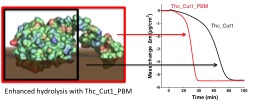
Perz, V. ; M.T. Zumstein; M. Sander, S. Zitzenbacher, D. Ribitsch, G.M. Gübitz. Biomimetic approach to enhance enzymatic hydrolysis of the synthetic polyester poly(1,4-butylene adipate) - Fusing binding modules to esterases. Biomacromolecules, 2015, 16 (12), 3889-3896; DOI: external page10.1021/acs.biomac.5b01219call_made
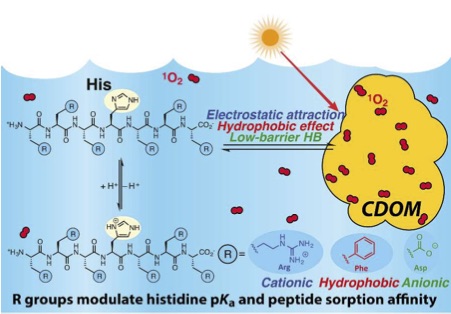
Chu, C. R. Lundeen, M. Sander, K. McNeill. Assessing the indirect photochemical transformation of dissolved combined amino acids through the use of systematically designed histidine-containing oligopeptides. Environ Sci Technol, 2015, 49, asap. DOI: external page10.1021/acs.est.5b03498call_made
Chiheng's second paper was just accepted in ES&T. In his paper, which is a continuation of an earlier study, Chiheng investigated the indirect photolysis of histidine-containing dissolved combined amino acids. More specifically, Chiheng systematically studied the effect of neighbouring photostable amino acids, including aliphatic, cationic, anionic and aromatic residues) on the reactivity of the histidine residue with singlet oxygen. The study shows that the reactivity of histidine is modulated by the neighbouring amino acids. In systems containing chromophoric dissolved organic matter (cDOM), association of the oligopeptides with cDOM resulted in enhanced indirect photolysis of the histidine residues, due to elevated concentrations of singlet oxygen in and around the cDOM associations. This work shows that photostable amino acids in oligopeptides can largely modulate the indirect photochemistry of photolabile amino acids, particularly in systems in which the oligopeptides associate with natural photosensitizers.
Michael (S) attends the 5th international symposium on soil organic matter in Göttigen, Germany and will give an invited talk in the session "SOM under reduced conditions". The title of the contribution is "Electron transfer to and from dissolved and particulate organic matter - from electrochemical interrogation to redox dynamics in peatlands".
Laura has successfully defended her PhD work! Congratulations!
The title of her thesis is "Redox properties and dynamics of natural organic matter as assessed by mediated electrochemical analysis". The external committee member was external pageProf. Thorsten Dittmarcall_made (Carl von Ossietzky Universität Oldenburg and MPI Bremen)
The picture on the left shows Laura in July 2014 on the road to Värmland, Sweden (field trip).
Kurt and Michael attended the Goldschmidt 2015 Conference in Prague. Kurt gave a presentation on the redox properties of peat organic matter (external pagelinkcall_made) and Michael on the enzymatic oxidation of dissolved organic matter (external pagelinkcall_made).
Michael also chaired a session with external pageChristy Remucalcall_made and external pageChristopher Gorskicall_made on external pageRedox and Radical Biogeochemistrycall_made. Both Christy and Chris were postdoctoral researchers in Zurich some years ago. Kurt and Michael also met external pageMax Laucall_made at Goldschmidt with whom both had been on a field trip to Sweden in 2014. It was great to catch up!
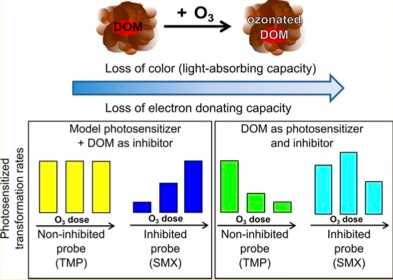
Wenk, J., M. Aeschbacher, M. Sander, U. von Gunten, and S. Canonica. Photosensitizing and inhibitory effects of ozonated dissolved organic matter on triplet-induced contaminant transformation. Environ Sci Technol, 2015, 49 (14), 8541; DOI: external page10.1021/acs.est.5b02221call_made
This paper focusses on the effect of ozonation on the photosensitizing and inhibitory effects of DOM on the phototransformation of organic contaminants. The research project was conceptualized and conducted by our colleagues at Eawag. Michael Aeschbacher and I contributed to the work by quantifying changes in the redox states of DOM upon ozonation using mediated electrochemical analysis.
This paper is a sequel to an earlier publication in ES&T in 2013 in which we assessed the changes in the optical and electrochemical properties of DOM upon treatment with different chemical oxidants (Wenk et al. Environ Sci Technol, 2013, 47, 11147-11156. DOI: external page10.1021/es402516bcall_made).
Electrochemistry has long been recognized as a very powerful approach to characterize the redox properties and reactivities of iron-containing minerals (including iron (oxyhydr)oxides as well as iron-bearing clay minerals). In this critical review, Chris (Gorski), Thomas (Hofstetter) and I attempted to provide an overview of studies on the topic. We critically reviewed both non-mediated approaches (which rely on direct electron transfer between the mineral and the working electrode) and mediated analyses (which use redox-active organic compounds to facilitate redox equilibration between the mineral and the working electrode). This review includes a detailed discussion of mediated electrochemical analyses approaches recently developed in our lab and successfully applied to iron-bearing clay minerals and organic geochemical phases.
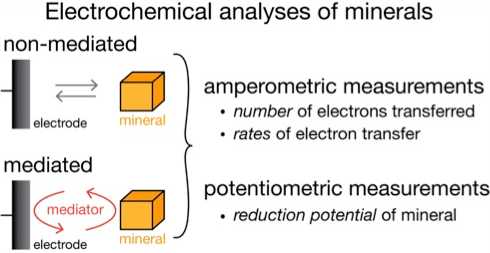
Sander, M., T.B. Hofstetter, C.A. Gorski. Electrochemical analyses of redox-active iron minerals: A review of non-mediated and mediated approaches. Environ Sci Technol, 2015, 49, 5862-5878. DOI: external page10.1021/acs.est.5b00006call_made
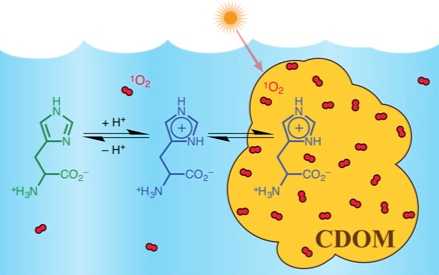
Chu, C.; R. Lundeen, C. Remucal, M. Sander, K. McNeill. Enhanced indirect photochemical transformation of histidine and histamine through association with chromophoric dissolved organic matter. Environ Sci Technol, 2015, 49, 5511-5519. DOI: external page10.1021/acs.est.5b00466call_made
While the direct phototransformation of amino acids in sunlit waters is well studied, the indirect photochemistry of amino acids in the presence of chromophoric dissolved organic matter (cDOM) is poorly studied and understood. In this paper, Chiheng reports the results of a systematic assessment of the transformation of histidine by single oxygen formed by photoirradiation of cDOM. The work shows that association of His with cDOM enhanced its phototransformation by exposure to elevated singlet oxygen concentrations in the cDOM microenvironment. Sorption-enhanced phototransformation of His was supported by loss of the enhancement upon adding a co-sorbate that competitively suppressed sorption of His. This work highlights that the association of amino acids (and likely larger oligopeptides as well as biomacromolecules) with cDOM may result in enhanced phototransformation of these molecules in natural systems.
Effluent organic matter (EfOM) from waste water treatment plants may alter the photochemical eactivities in the receiving water bodies. In this work, the quantum yield coefficients for excited triplet-state OM (3OM*) and apparent quantum yields for singlet oxygen (1O2) were measured in whole water samples (as well as organic matter isolates from these samples) collected upstream and downstream of municipal wastewater treatment plant discharges in three rivers receiving differing effluent contributions. This work shows that effluent contributions of up to 25% (v/v) to river systems have a negligible influence on photochemical production of 3OM* and 1O2, apparently because of quenching of triplet DOM by EfOM. This work was conceptualized and mainly conducted in the group of external pageAllison Mackaycall_made (UConn). I contributed to the work by quantifying the electron accepting and donating capacities of dissolved organic matter in the water samples.
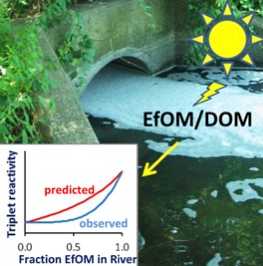
L.C. Bodhipaksha, C. M. Sharpless, Y.-P. Chin, M. Sander, W.K. Langston, and A. A. MacKay. Triplet photochemistry of effluent and natural organic matter in whole water and isolates from effluent-receiving rivers. Environ Sci Technol, 2015, 49, 3453–3463. DOI: external page10.1021/es505081wcall_made
Lau, M., M. Sander, J. Gelbrecht, M. Hupfer. Solid phases as important electron acceptors in freshwater organic sediments. Biogeochemistry. 2015. 123, 49-61. DOI: external page10.1007/s10533-014-0052-5call_made
In this paper, Max Lau systematically analyzed the microbial reduction of freshwater sediments, including particulate organic matter (POM) and of Fe(III) (oxyhydr-)oxides, during anoxic incubations. This study is the first to use mediated electrochemical analyses to analyze complex natural samples that contain more than one redox-active constituent. The work provides evidence that particulate organic matter is an important terminal electron acceptor in anaerobic microbial respiration in freshwater sediments. The work was conceptualized and led by Max Lau and his advisors Michael Hupfer and Jörg Gelbrecht.
On the left you can see how Max reacted when he heard that the paper was accepted ... no ... it shows Max in a peat bog in July 2014 when he participated on a field sampling campaign in Central Sweden.
2014
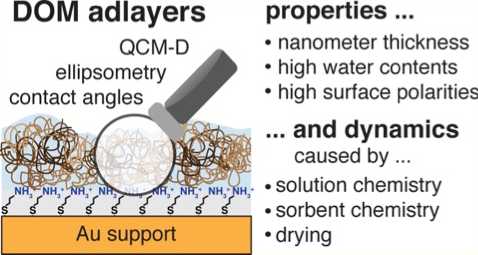
Armanious, A., Aeppli, M. and M. Sander. Dissolved organic matter adsorption to model surfaces: adlayer formation, properties and dynamics at the nanoscale. Environ Sci Technol, 2014, 48, 9420–9429. DOI: external page10.1021/es5026917call_made
In this paper, Tony reports on the nanoscalar properties and dynamics of DOM adlayers formed from a diverse set of eight humic and fulvic acids, used as DOM models, on model surfaces that vary in charge and polarity. Tony found that, on positively charged surfaces, DOM formed water-rich adlayers with nanometer thicknesses that were relatively rigid, irreversibly adsorbed, and collapsed upon air drying. The DOM adlayer thicknesses varied only slightly with solution pH from 5 to 8 but increased markedly with increasing ionic strength. The surfaces of the adlayers are relatively polar. Finally, using laccase adsorption to the DOM adlayers as an example, Tony demonstrated the applicability of the presented experimental approach to study the interactions of (bio)macromolecules and (nano)particles with DOM.

